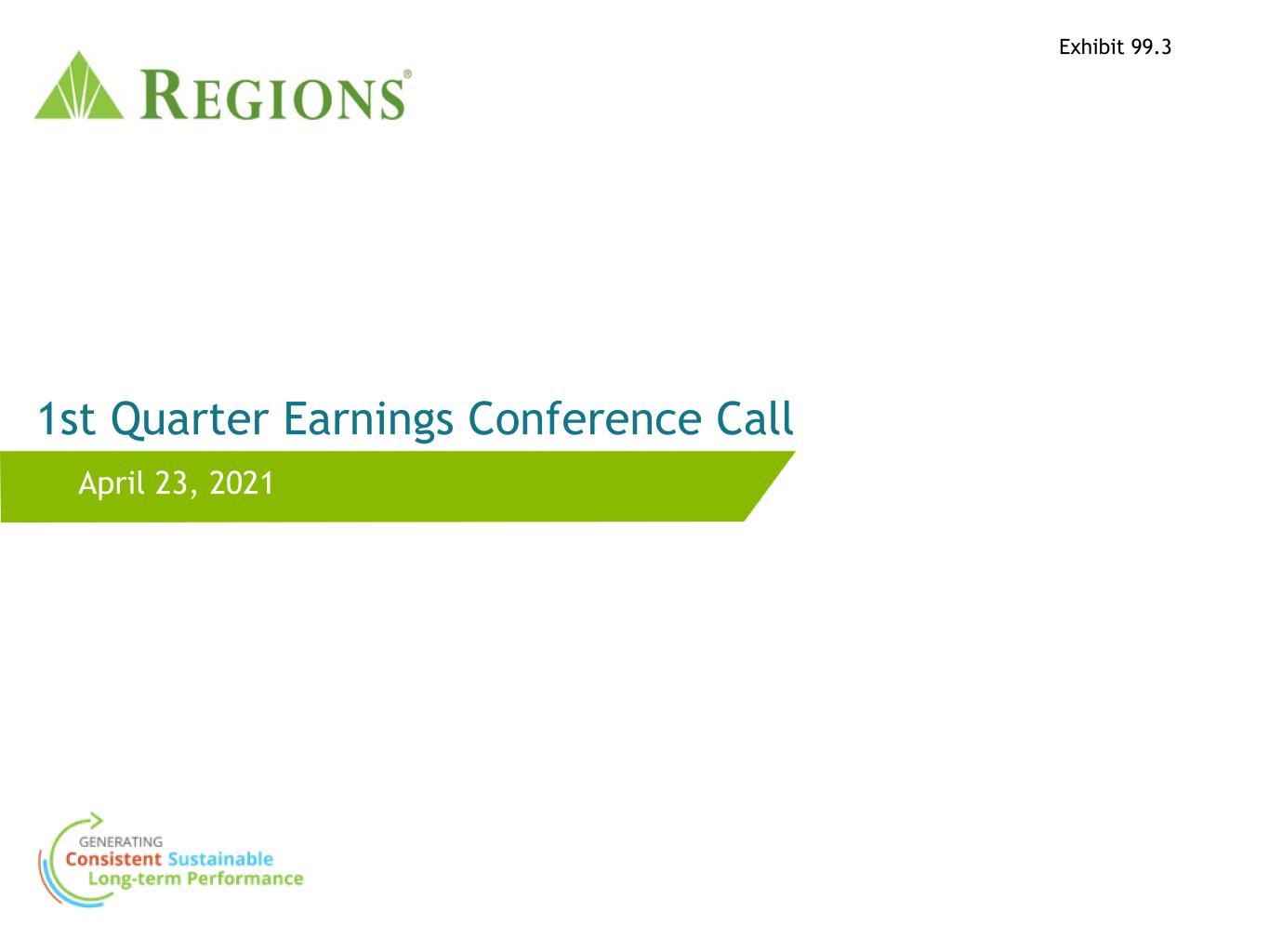
Exhibit 99.3 1st Quarter Earnings Conference Call April 23, 2021
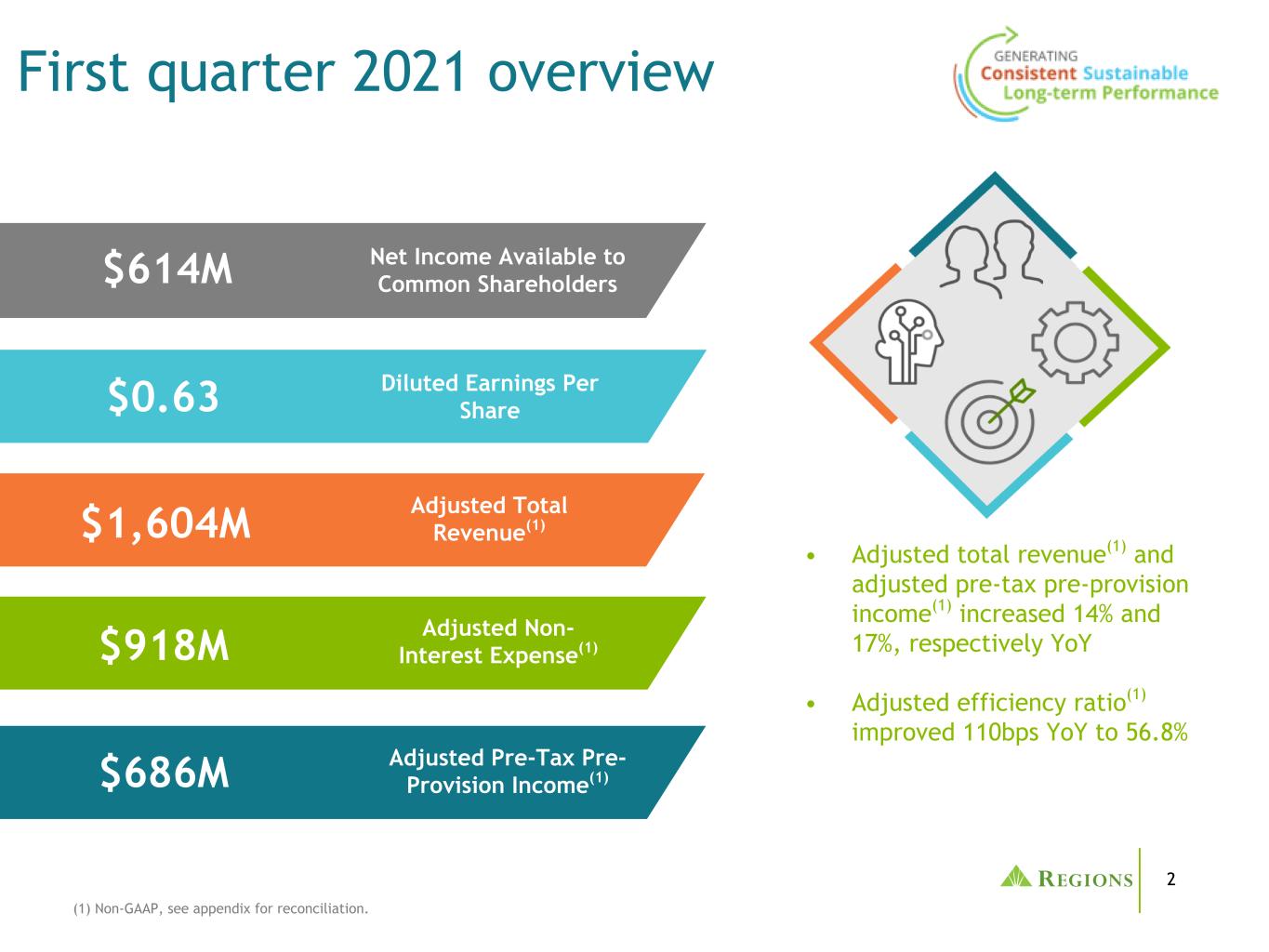
2 First quarter 2021 overview (1) Non-GAAP, see appendix for reconciliation. Adjusted Pre-Tax Pre- Provision Income(1) Diluted Earnings Per Share Adjusted Total Revenue(1) Adjusted Non- Interest Expense(1) Net Income Available to Common Shareholders $686M $0.63 $1,604M $918M $614M • Adjusted total revenue(1) and adjusted pre-tax pre-provision income(1) increased 14% and 17%, respectively YoY • Adjusted efficiency ratio(1) improved 110bps YoY to 56.8%
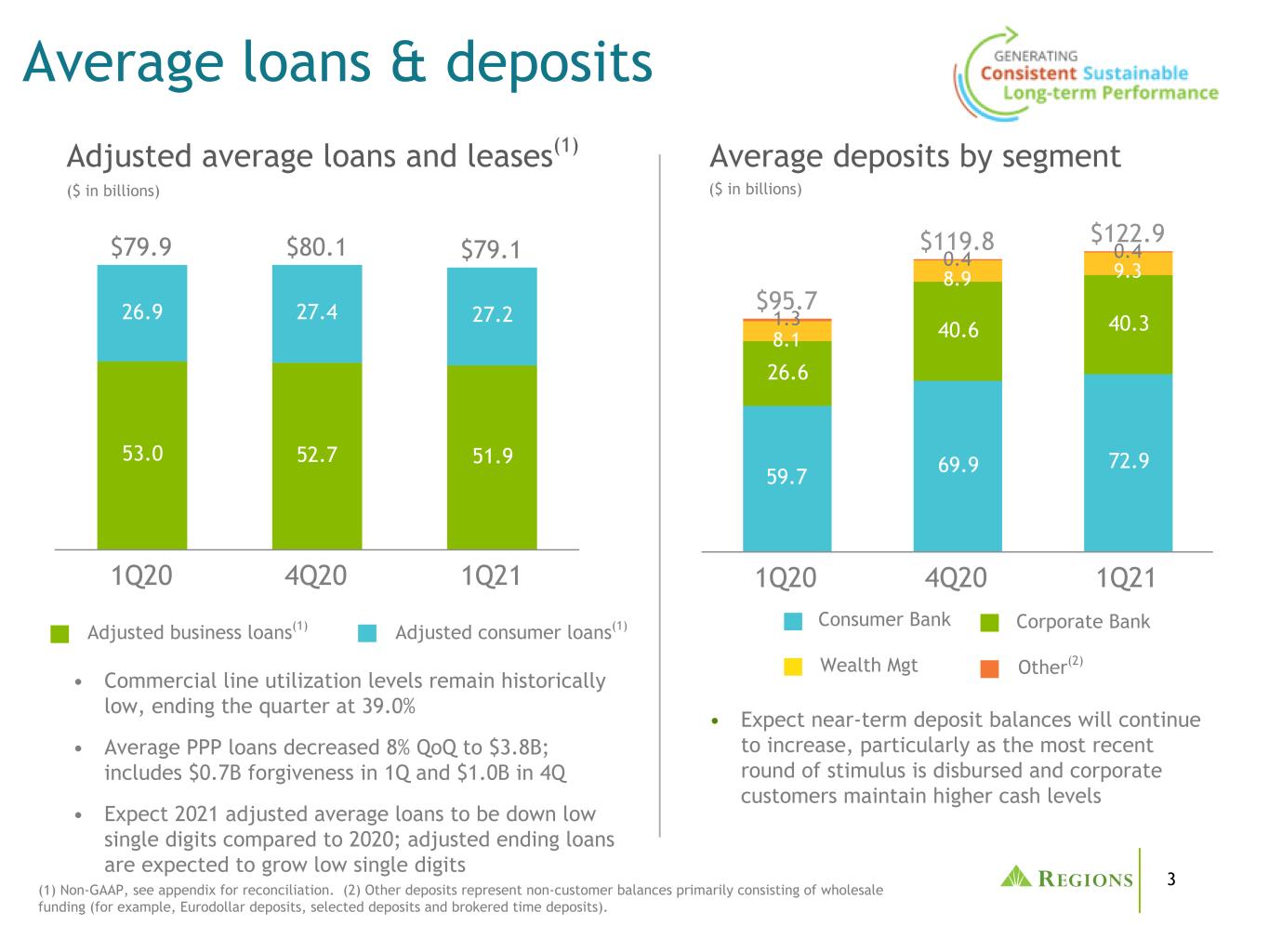
3 $95.7 $119.8 $122.9 59.7 69.9 72.9 26.6 40.6 40.38.1 8.9 9.3 1.3 0.4 0.4 1Q20 4Q20 1Q21 Average loans & deposits (1) Non-GAAP, see appendix for reconciliation. (2) Other deposits represent non-customer balances primarily consisting of wholesale funding (for example, Eurodollar deposits, selected deposits and brokered time deposits). Average deposits by segment ($ in billions) Wealth Mgt Other(2) Consumer Bank Corporate Bank • Expect near-term deposit balances will continue to increase, particularly as the most recent round of stimulus is disbursed and corporate customers maintain higher cash levels $79.9 $80.1 $79.1 53.0 52.7 51.9 26.9 27.4 27.2 1Q20 4Q20 1Q21 Adjusted average loans and leases(1) ($ in billions) Adjusted business loans(1) Adjusted consumer loans(1) • Commercial line utilization levels remain historically low, ending the quarter at 39.0% • Average PPP loans decreased 8% QoQ to $3.8B; includes $0.7B forgiveness in 1Q and $1.0B in 4Q • Expect 2021 adjusted average loans to be down low single digits compared to 2020; adjusted ending loans are expected to grow low single digits

4 $940 $1,017 $978 3.44% 3.13% 3.02% 3.40% 3.40% 1Q20 4Q20 1Q21 NII(1) Net interest income and net interest margin - liquidity impacts NII(1) and NIM ($ in millions) (1) Net interest income (NII) on a fully taxable equivalent basis. (2) Non-GAAP; see appendix for reconciliation. NIM • In 1Q, deposit and cash balances remained elevated given stimulus / liquidity in the system • PPP and cash account for -38 bps NIM and +$42M NII within the quarter (-11bps / -$13M QoQ) ◦ PPP loans account for +4 bps NIM and +$40M NII within the quarter (-3bps / -$14M QoQ) ◦ Excess cash accounts for -42 bps NIM and +$2M NII (-8bps / $1M QoQ) • Total of $13.5B active cash deployment in 2020, balancing risk and return NIM excl. PPP/Cash(2)
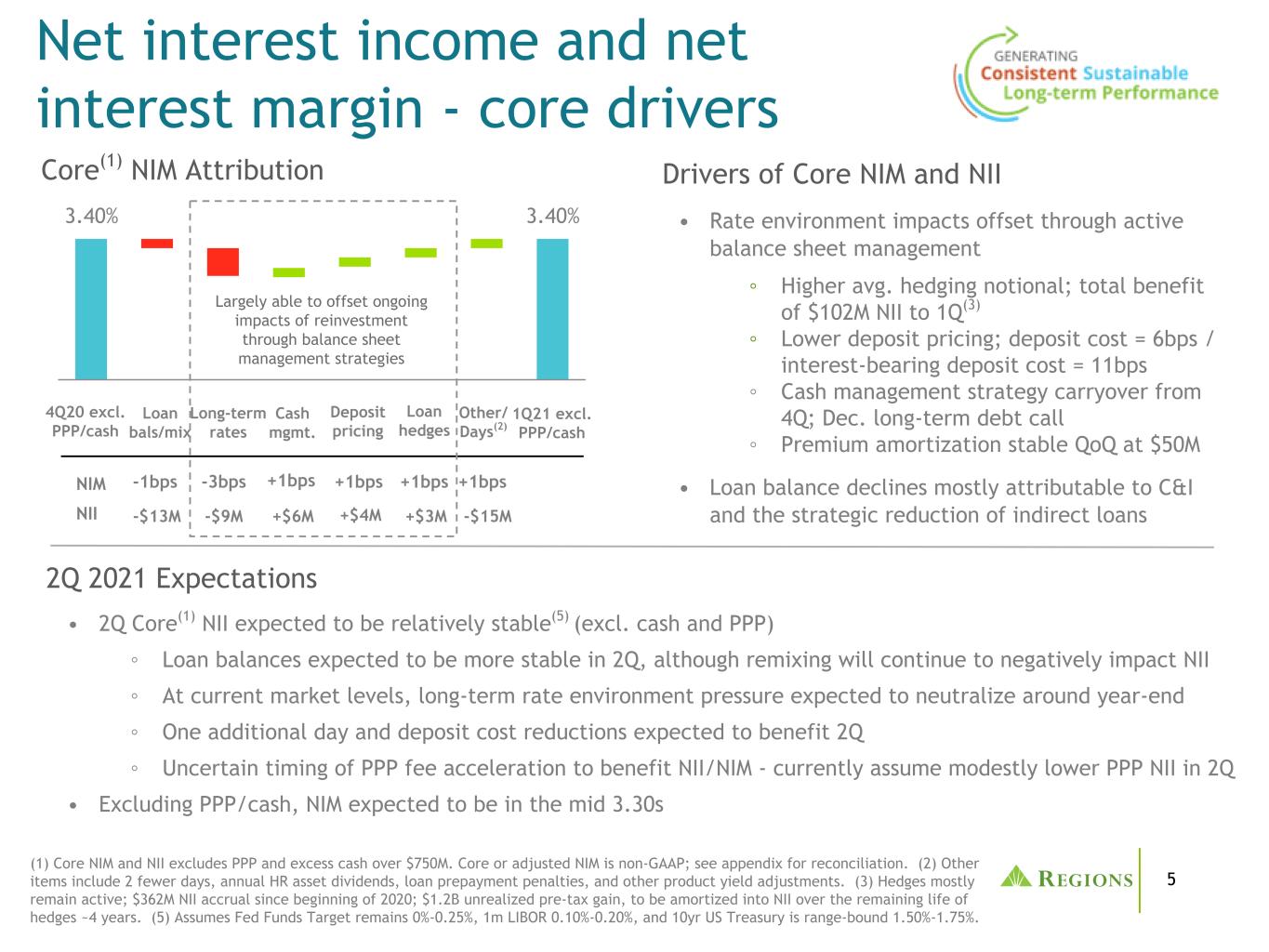
5 • Rate environment impacts offset through active balance sheet management ◦ Higher avg. hedging notional; total benefit of $102M NII to 1Q(3) ◦ Lower deposit pricing; deposit cost = 6bps / interest-bearing deposit cost = 11bps ◦ Cash management strategy carryover from 4Q; Dec. long-term debt call ◦ Premium amortization stable QoQ at $50M • Loan balance declines mostly attributable to C&I and the strategic reduction of indirect loans (1) Core NIM and NII excludes PPP and excess cash over $750M. Core or adjusted NIM is non-GAAP; see appendix for reconciliation. (2) Other items include 2 fewer days, annual HR asset dividends, loan prepayment penalties, and other product yield adjustments. (3) Hedges mostly remain active; $362M NII accrual since beginning of 2020; $1.2B unrealized pre-tax gain, to be amortized into NII over the remaining life of hedges ~4 years. (5) Assumes Fed Funds Target remains 0%-0.25%, 1m LIBOR 0.10%-0.20%, and 10yr US Treasury is range-bound 1.50%-1.75%. 3.40% 3.40% Net interest income and net interest margin - core drivers Core(1) NIM Attribution Drivers of Core NIM and NII 1Q21 excl. PPP/cash 4Q20 excl. PPP/cash -1bps +1bps +1bps +1bps-3bps -$13M +$6M +$4M +$3M-$9M -$15M NIM NII • 2Q Core(1) NII expected to be relatively stable(5) (excl. cash and PPP) ◦ Loan balances expected to be more stable in 2Q, although remixing will continue to negatively impact NII ◦ At current market levels, long-term rate environment pressure expected to neutralize around year-end ◦ One additional day and deposit cost reductions expected to benefit 2Q ◦ Uncertain timing of PPP fee acceleration to benefit NII/NIM - currently assume modestly lower PPP NII in 2Q • Excluding PPP/cash, NIM expected to be in the mid 3.30s 2Q 2021 Expectations Other/ Days(2) +1bps Loan bals/mix Cash mgmt. Long-term rates Deposit pricing Loan hedges Largely able to offset ongoing impacts of reinvestment through balance sheet management strategies
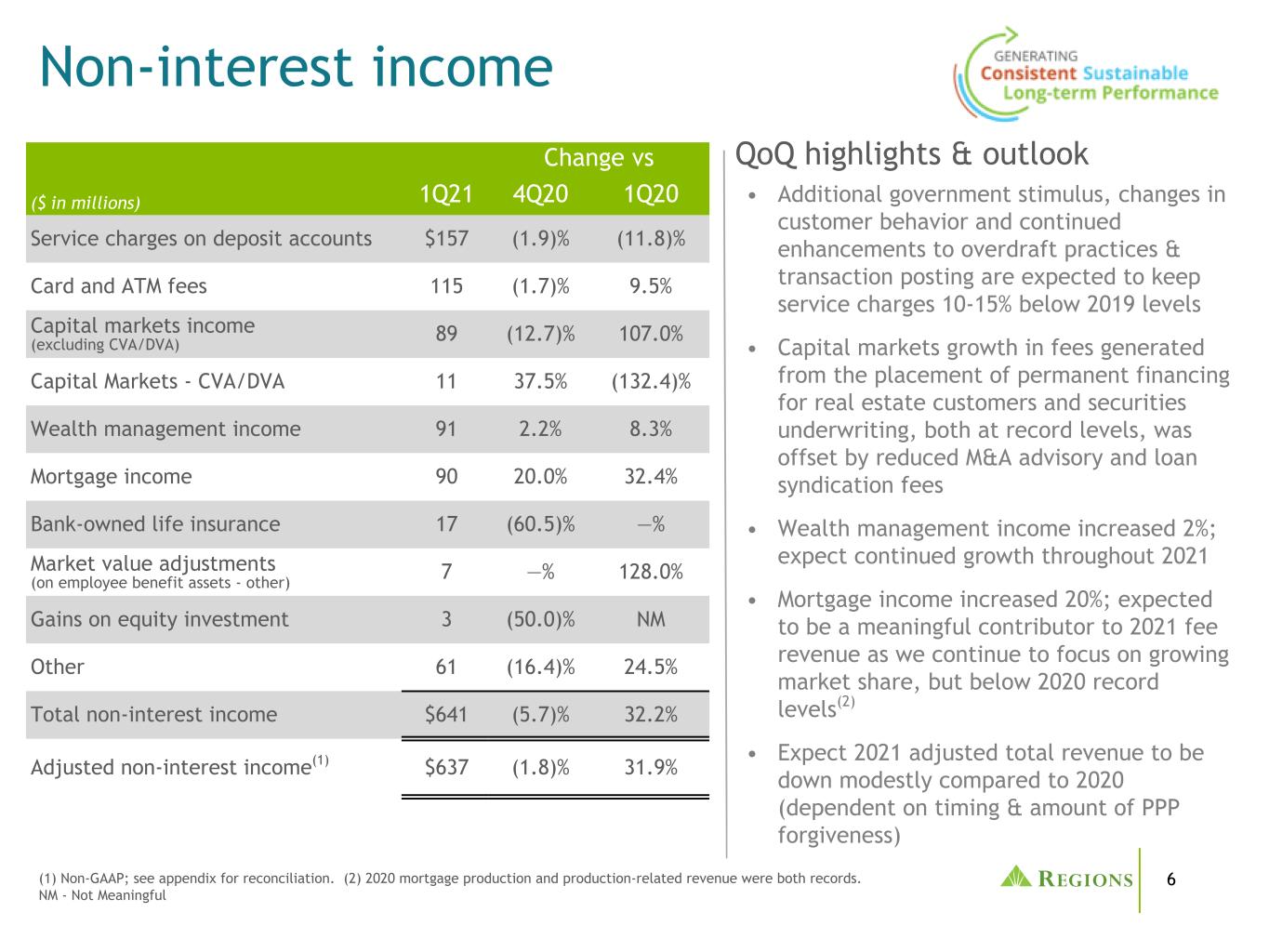
6 • Additional government stimulus, changes in customer behavior and continued enhancements to overdraft practices & transaction posting are expected to keep service charges 10-15% below 2019 levels • Capital markets growth in fees generated from the placement of permanent financing for real estate customers and securities underwriting, both at record levels, was offset by reduced M&A advisory and loan syndication fees • Wealth management income increased 2%; expect continued growth throughout 2021 • Mortgage income increased 20%; expected to be a meaningful contributor to 2021 fee revenue as we continue to focus on growing market share, but below 2020 record levels(2) • Expect 2021 adjusted total revenue to be down modestly compared to 2020 (dependent on timing & amount of PPP forgiveness) Change vs ($ in millions) 1Q21 4Q20 1Q20 Service charges on deposit accounts $157 (1.9)% (11.8)% Card and ATM fees 115 (1.7)% 9.5% Capital markets income (excluding CVA/DVA) 89 (12.7)% 107.0% Capital Markets - CVA/DVA 11 37.5% (132.4)% Wealth management income 91 2.2% 8.3% Mortgage income 90 20.0% 32.4% Bank-owned life insurance 17 (60.5)% —% Market value adjustments (on employee benefit assets - other) 7 —% 128.0% Gains on equity investment 3 (50.0)% NM Other 61 (16.4)% 24.5% Total non-interest income $641 (5.7)% 32.2% Adjusted non-interest income(1) $637 (1.8)% 31.9% Non-interest income (1) Non-GAAP; see appendix for reconciliation. (2) 2020 mortgage production and production-related revenue were both records. NM - Not Meaningful QoQ highlights & outlook
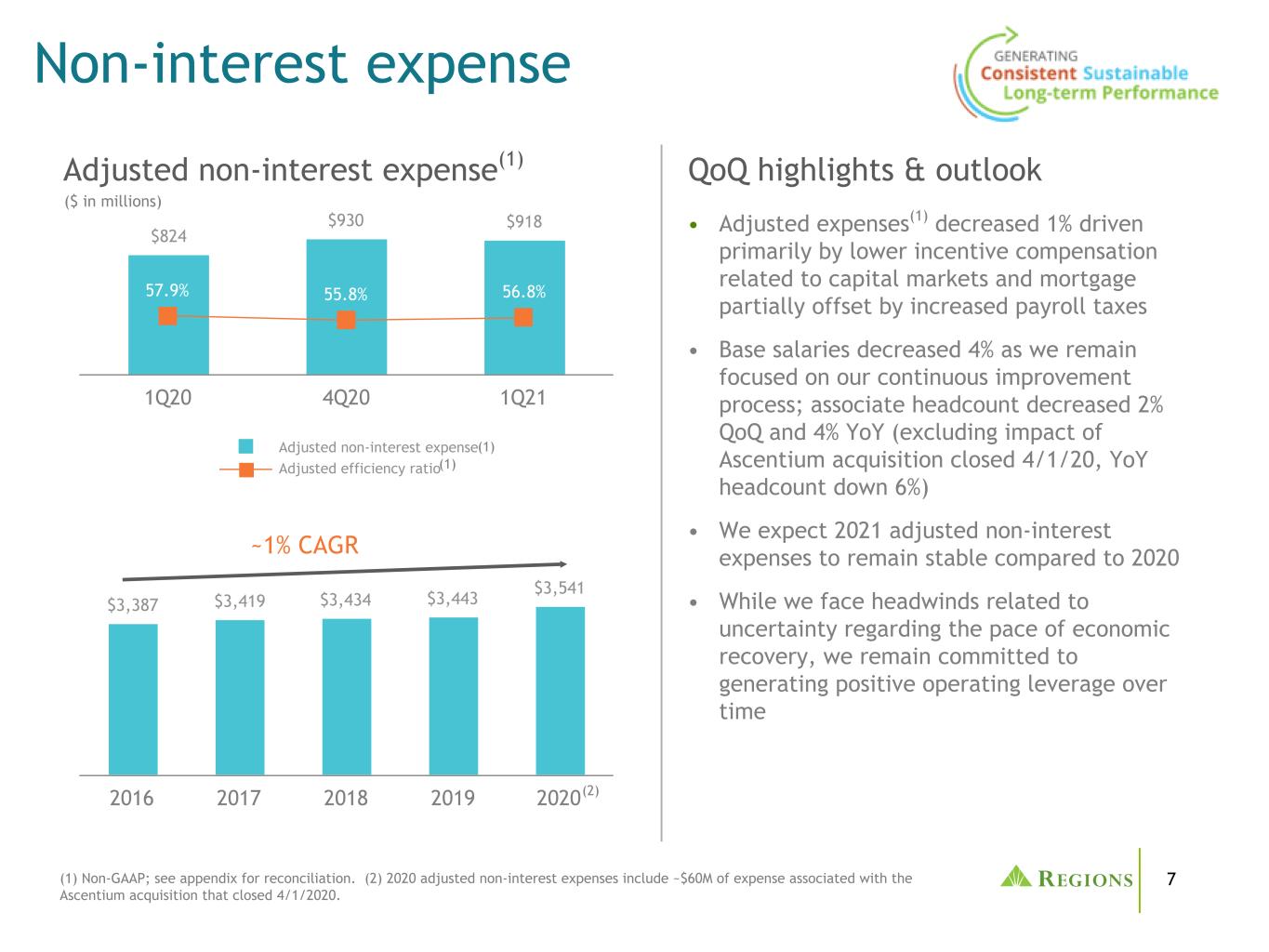
7(1) Non-GAAP; see appendix for reconciliation. (2) 2020 adjusted non-interest expenses include ~$60M of expense associated with the Ascentium acquisition that closed 4/1/2020. • Adjusted expenses(1) decreased 1% driven primarily by lower incentive compensation related to capital markets and mortgage partially offset by increased payroll taxes • Base salaries decreased 4% as we remain focused on our continuous improvement process; associate headcount decreased 2% QoQ and 4% YoY (excluding impact of Ascentium acquisition closed 4/1/20, YoY headcount down 6%) • We expect 2021 adjusted non-interest expenses to remain stable compared to 2020 • While we face headwinds related to uncertainty regarding the pace of economic recovery, we remain committed to generating positive operating leverage over time $3,387 $3,419 $3,434 $3,443 $3,541 2016 2017 2018 2019 2020 Non-interest expense QoQ highlights & outlookAdjusted non-interest expense(1) ($ in millions) $824 $930 $918 57.9% 55.8% 56.8% Adjusted non-interest expense Adjusted efficiency ratio 1Q20 4Q20 1Q21 ~1% CAGR (1) (1) (2)
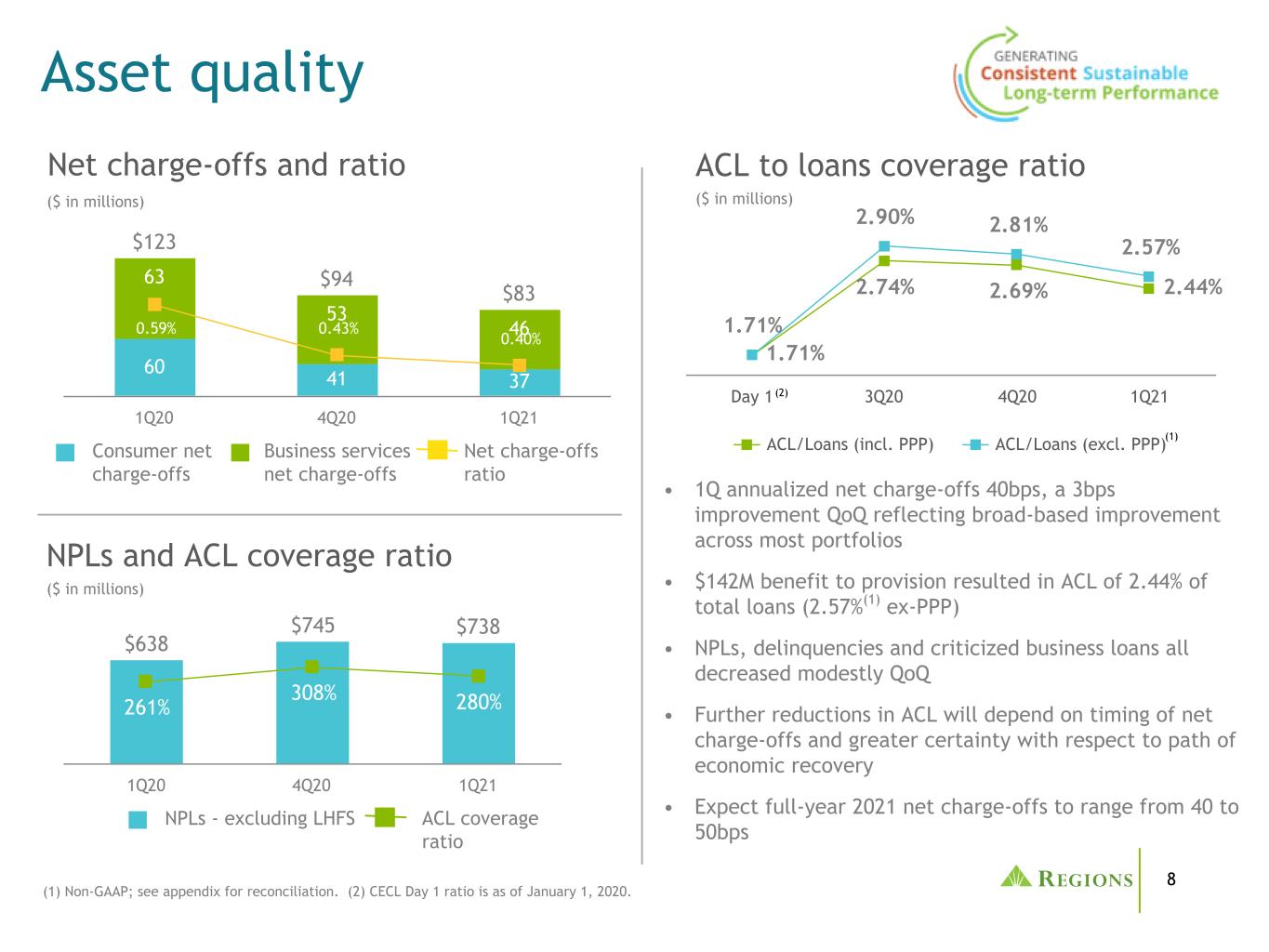
8 $123 $94 $83 60 41 37 63 53 460.59% 0.43% 0.40% 1Q20 4Q20 1Q21 $638 $745 $738 261% 308% 280% 1Q20 4Q20 1Q21 NPLs and ACL coverage ratio Asset quality ($ in millions) ($ in millions) ($ in millions) Net charge-offs and ratio NPLs - excluding LHFS ACL coverage ratio Consumer net charge-offs Business services net charge-offs Net charge-offs ratio (1) Non-GAAP; see appendix for reconciliation. (2) CECL Day 1 ratio is as of January 1, 2020. • 1Q annualized net charge-offs 40bps, a 3bps improvement QoQ reflecting broad-based improvement across most portfolios • $142M benefit to provision resulted in ACL of 2.44% of total loans (2.57%(1) ex-PPP) • NPLs, delinquencies and criticized business loans all decreased modestly QoQ • Further reductions in ACL will depend on timing of net charge-offs and greater certainty with respect to path of economic recovery • Expect full-year 2021 net charge-offs to range from 40 to 50bps ACL to loans coverage ratio 1.71% 2.74% 2.69% 2.44% 1.71% 2.90% 2.81% 2.57% ACL/Loans (incl. PPP) ACL/Loans (excl. PPP) Day 1 3Q20 4Q20 1Q21(2) (1)
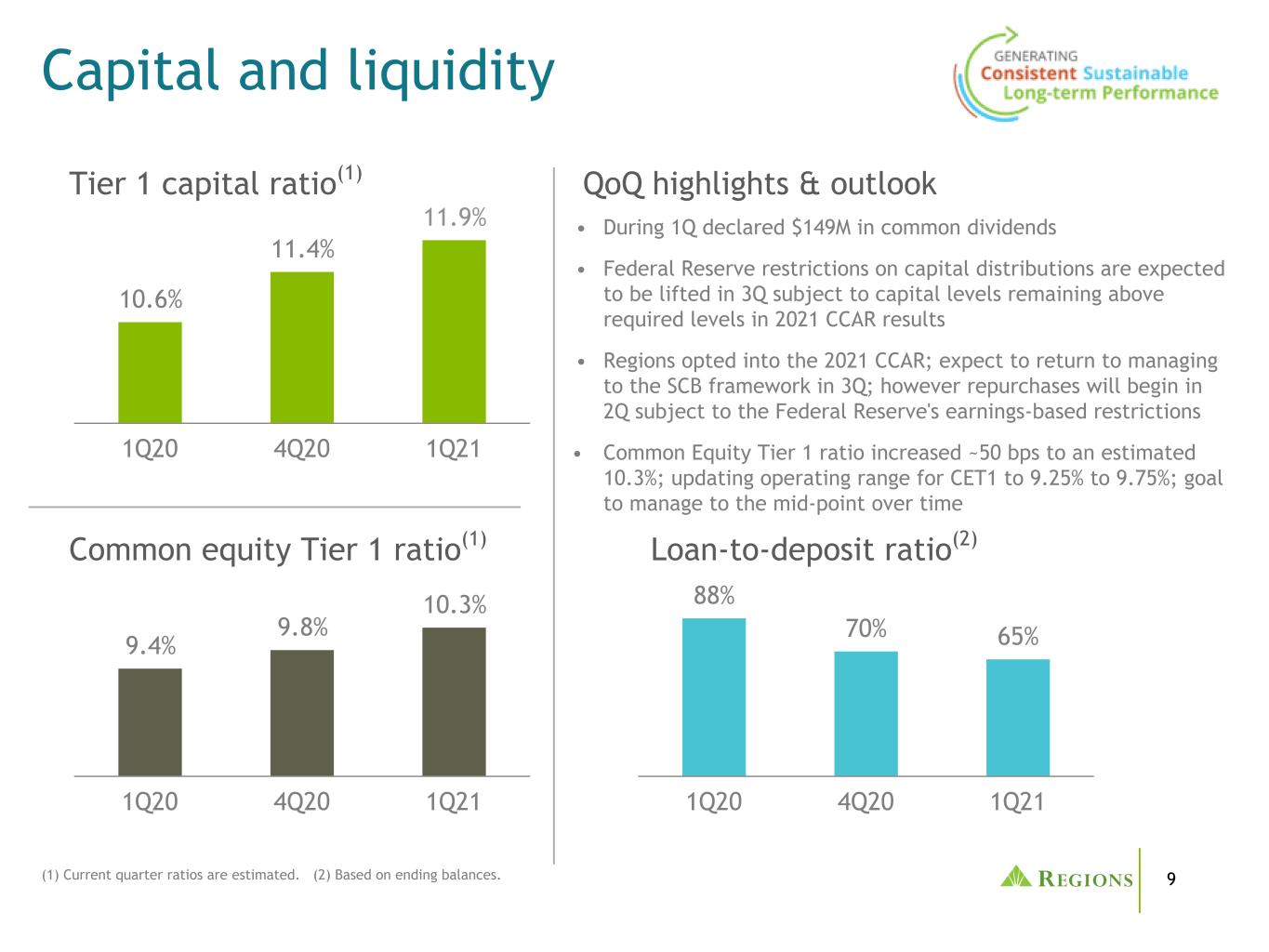
9 • During 1Q declared $149M in common dividends • Federal Reserve restrictions on capital distributions are expected to be lifted in 3Q subject to capital levels remaining above required levels in 2021 CCAR results • Regions opted into the 2021 CCAR; expect to return to managing to the SCB framework in 3Q; however repurchases will begin in 2Q subject to the Federal Reserve's earnings-based restrictions • Common Equity Tier 1 ratio increased ~50 bps to an estimated 10.3%; updating operating range for CET1 to 9.25% to 9.75%; goal to manage to the mid-point over time QoQ highlights & outlook Common equity Tier 1 ratio(1) 9.4% 9.8% 10.3% 1Q20 4Q20 1Q21 10.6% 11.4% 11.9% 1Q20 4Q20 1Q21 Tier 1 capital ratio(1) Capital and liquidity (1) Current quarter ratios are estimated. (2) Based on ending balances. Loan-to-deposit ratio(2) 88% 70% 65% 1Q20 4Q20 1Q21
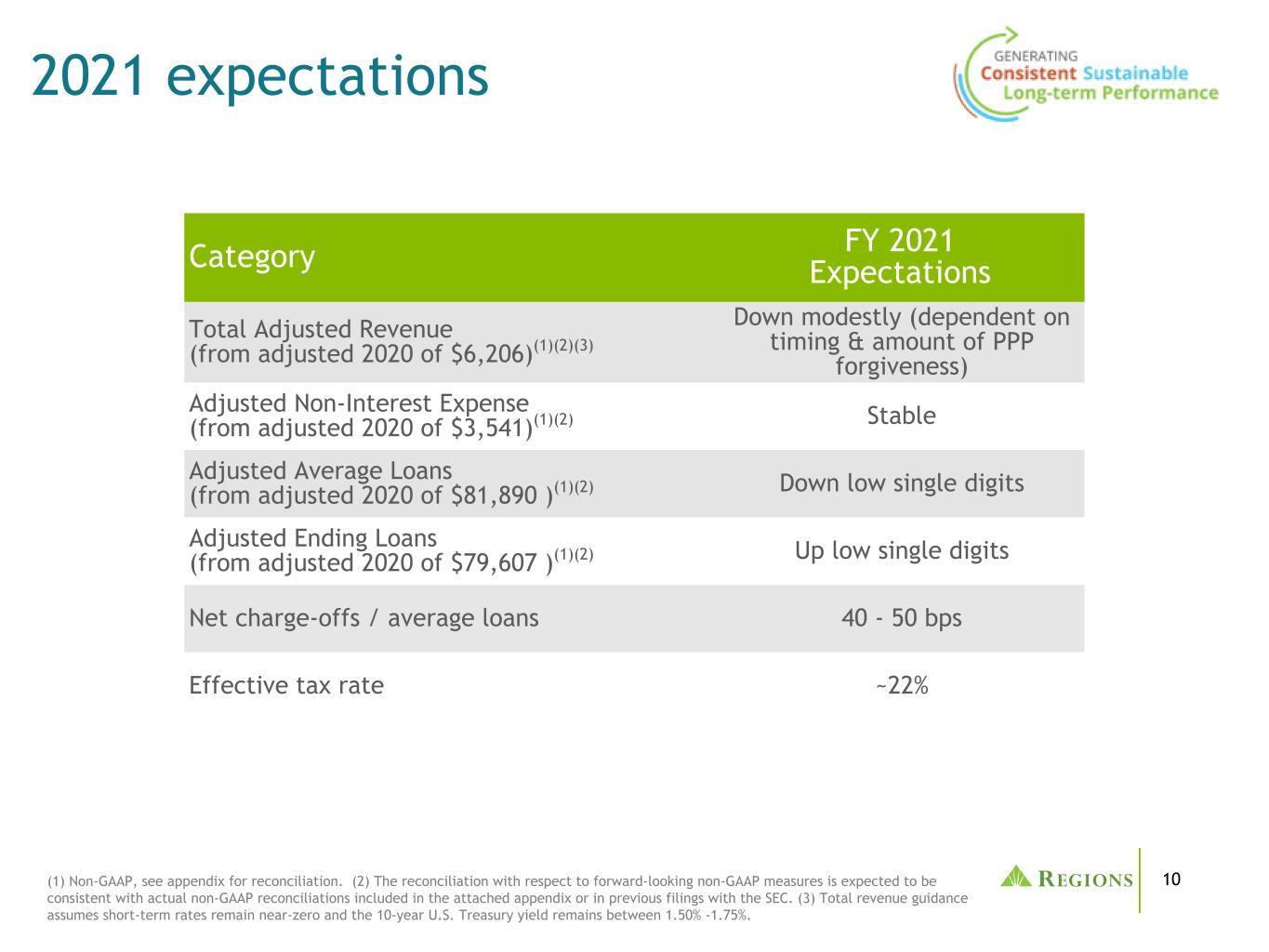
10 2021 expectations (1) Non-GAAP, see appendix for reconciliation. (2) The reconciliation with respect to forward-looking non-GAAP measures is expected to be consistent with actual non-GAAP reconciliations included in the attached appendix or in previous filings with the SEC. (3) Total revenue guidance assumes short-term rates remain near-zero and the 10-year U.S. Treasury yield remains between 1.50% -1.75%. Category FY 2021 Expectations Total Adjusted Revenue (from adjusted 2020 of $6,206)(1)(2)(3) Down modestly (dependent on timing & amount of PPP forgiveness) Adjusted Non-Interest Expense (from adjusted 2020 of $3,541)(1)(2) Stable Adjusted Average Loans (from adjusted 2020 of $81,890 )(1)(2) Down low single digits Adjusted Ending Loans (from adjusted 2020 of $79,607 )(1)(2) Up low single digits Net charge-offs / average loans 40 - 50 bps Effective tax rate ~22%
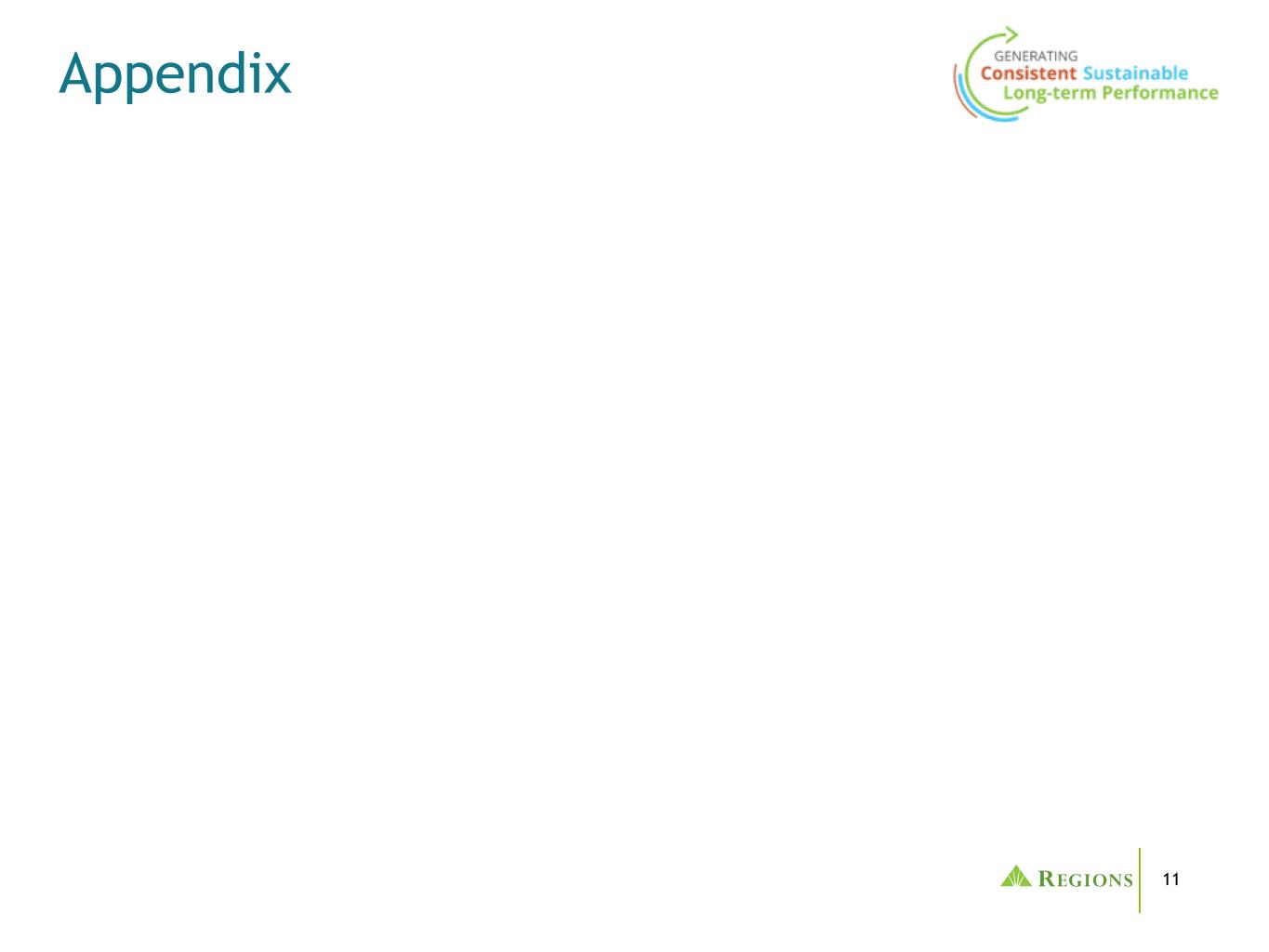
11 Appendix

12 Selected items impact First quarter 2021 highlights (1) Non-GAAP, see appendix for reconciliation. (2) Based on income taxes at an approximate 25% incremental rate. (3) Items impacting results or trends during the quarter, but are not considered non-GAAP adjustments. These items generally include market-related measures, impacts of new accounting guidance, or event driven actions. (4) The 1Q21 amount reflects a gain on sale of an equity investment. NM - Not Meaningful ($ amounts in millions, except per share data) 1Q21 QoQ Change YoY Change Net interest income $ 967 (3.9)% 4.2% Provision for (benefit from) credit losses (142) 273.7% NM Non-interest income 641 (5.7)% 32.2% Non-interest expense 928 (6.0)% 11.0% Income before income taxes 822 11.5% 302.9% Income tax expense 180 48.8% 328.6% Net income 642 4.2% 296.3% Preferred dividends 28 —% 21.7% Net income available to common shareholders $ 614 4.4% 341.7% Diluted EPS $ 0.63 3.3% 350.0% Summary of first quarter results (amounts in millions, except per share data) 1Q21 Pre-tax adjusted items(1): Contribution to the Regions Financial Corporation foundation $ (2) Branch consolidation, property and equipment charges (5) Salary and employee benefits—severance charges $ (3) Securities gains (losses), net 1 Valuation gain on equity investment(4) 3 Total pre-tax adjusted items(1) $ (6) Diluted EPS impact(2) $ — Additional selected items(3): CECL provision less than (in excess of) net charge-offs $ 225 Capital markets income - CVA/DVA 11 MSR net hedge performance 7 PPP loans interest/fee income 40
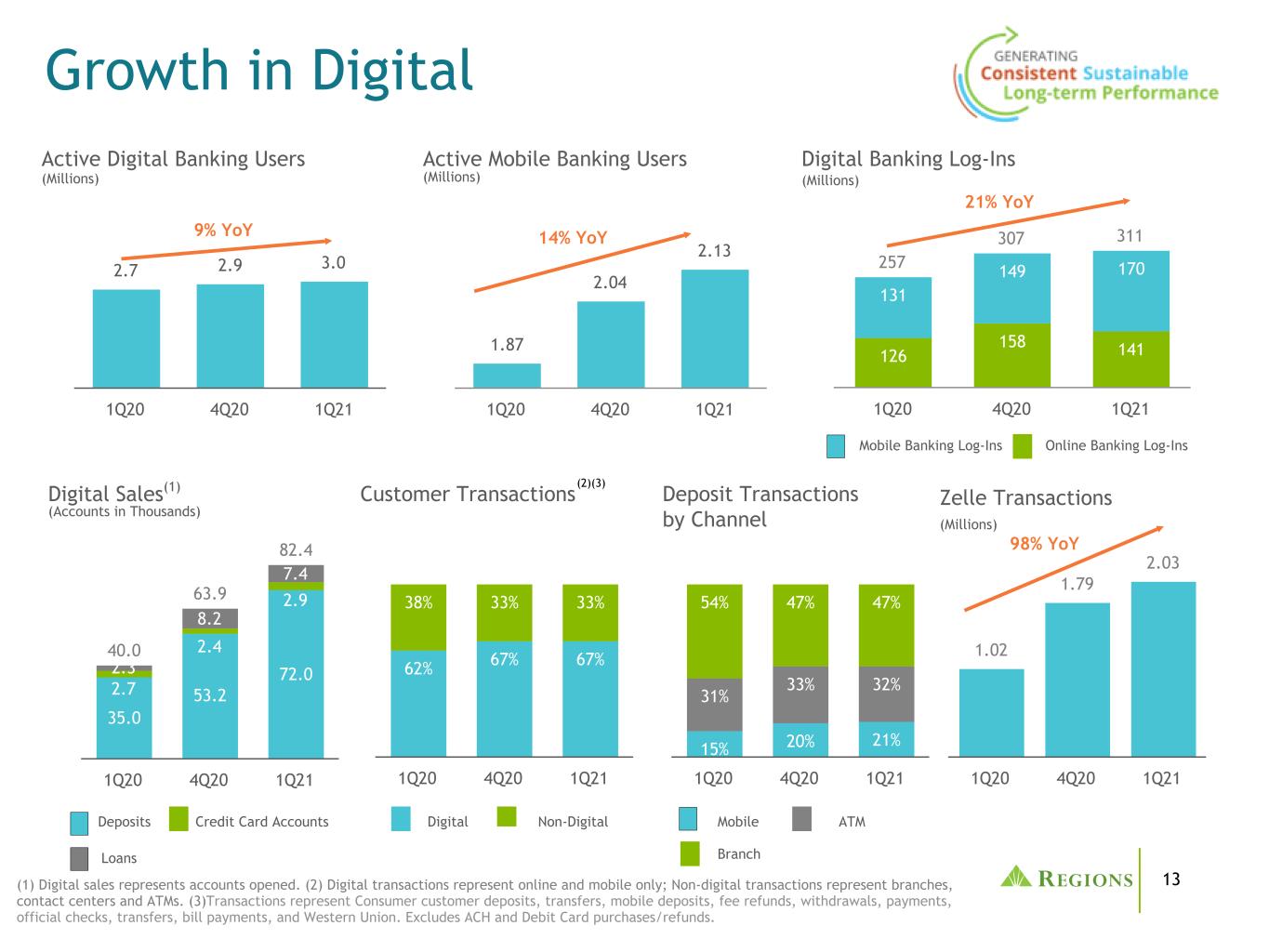
13 1.02 1.79 2.03 1Q20 4Q20 1Q21 257 307 311 126 158 141 131 149 170 1Q20 4Q20 1Q21 2.7 2.9 3.0 1Q20 4Q20 1Q21 Mobile Banking Log-Ins 1.87 2.04 2.13 1Q20 4Q20 1Q21 15% 20% 21% 31% 33% 32% 54% 47% 47% 1Q20 4Q20 1Q21 40.0 63.9 82.4 35.0 53.2 72.0 2.7 2.4 2.9 2.3 8.2 7.4 1Q20 4Q20 1Q21 62% 67% 67% 38% 33% 33% 1Q20 4Q20 1Q21 Growth in Digital Digital Banking Log-Ins Customer Transactions Deposit Transactions by Channel 21% YoY 9% YoY (Millions) (Millions) Active Digital Banking Users Active Mobile Banking Users (Millions) 14% YoY Online Banking Log-Ins Loans Digital Sales(1) (Accounts in Thousands) Deposits Credit Card Accounts Digital Non-Digital Mobile ATM Branch (1) Digital sales represents accounts opened. (2) Digital transactions represent online and mobile only; Non-digital transactions represent branches, contact centers and ATMs. (3)Transactions represent Consumer customer deposits, transfers, mobile deposits, fee refunds, withdrawals, payments, official checks, transfers, bill payments, and Western Union. Excludes ACH and Debit Card purchases/refunds. (2)(3) Zelle Transactions (Millions) 98% YoY
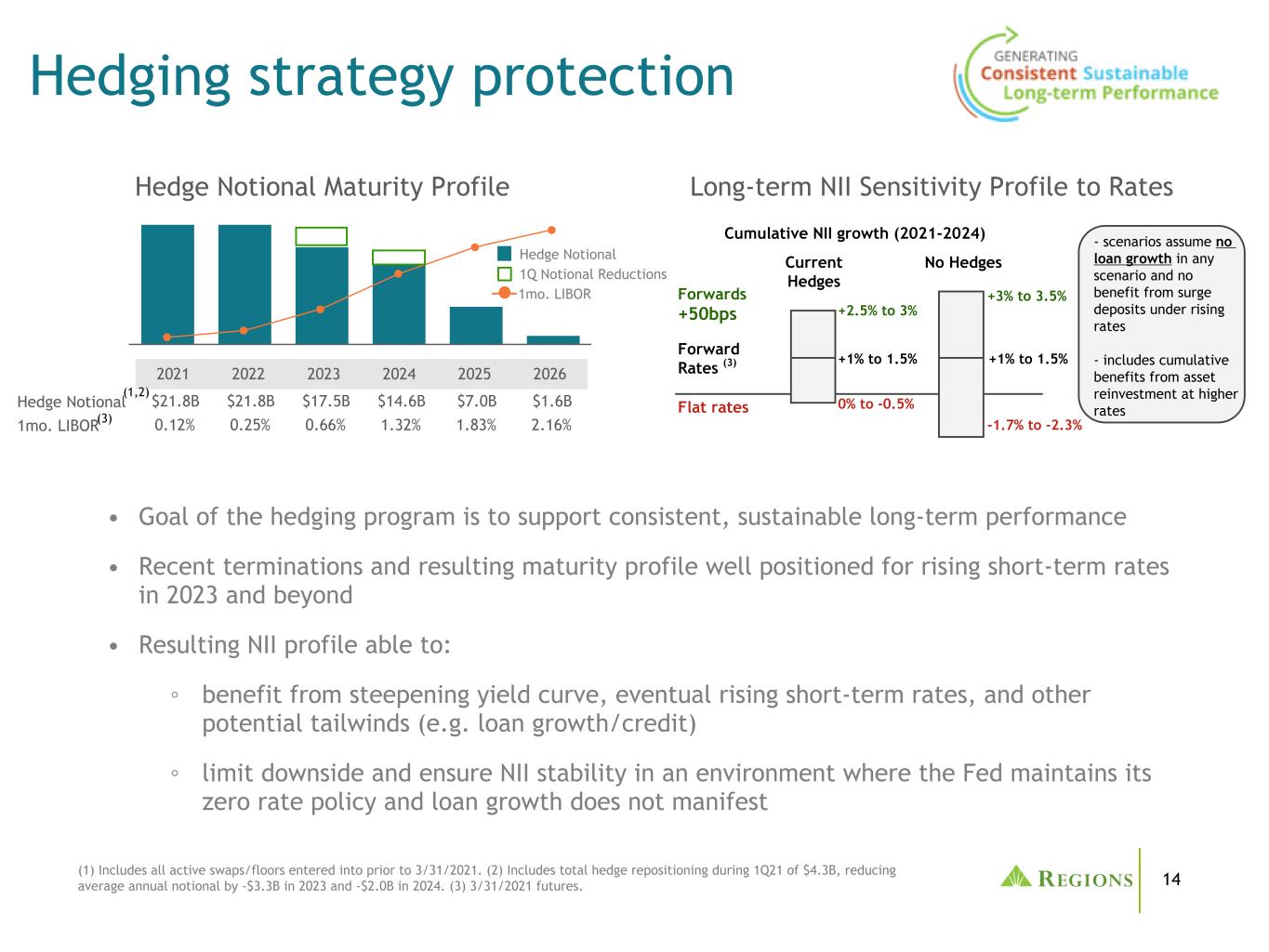
14 +1% to 1.5% Long-term NII Sensitivity Profile to Rates 1 2 3 4 5 6 Hedging strategy protection (1) Includes all active swaps/floors entered into prior to 3/31/2021. (2) Includes total hedge repositioning during 1Q21 of $4.3B, reducing average annual notional by -$3.3B in 2023 and -$2.0B in 2024. (3) 3/31/2021 futures. Hedge Notional Maturity Profile 2021 2022 2023 2024 2025 2026 Hedge Notional $21.8B $21.8B $17.5B $14.6B $7.0B $1.6B 1mo. LIBOR 0.12% 0.25% 0.66% 1.32% 1.83% 2.16% 1mo. LIBOR Hedge Notional Forward Rates (3) (1,2) 1Q Notional Reductions - scenarios assume no loan growth in any scenario and no benefit from surge deposits under rising rates - includes cumulative benefits from asset reinvestment at higher rates (3) Forwards +50bps Cumulative NII growth (2021-2024) Flat rates Current Hedges No Hedges +2.5% to 3% +3% to 3.5% 0% to -0.5% +1% to 1.5% -1.7% to -2.3% • Goal of the hedging program is to support consistent, sustainable long-term performance • Recent terminations and resulting maturity profile well positioned for rising short-term rates in 2023 and beyond • Resulting NII profile able to: ◦ benefit from steepening yield curve, eventual rising short-term rates, and other potential tailwinds (e.g. loan growth/credit) ◦ limit downside and ensure NII stability in an environment where the Fed maintains its zero rate policy and loan growth does not manifest

15 10.7%10.5% 9.6% 9.1% 8.9% 6.1% 5.7% 5.1% 3.8% 2.7% 2.5% 0.6% 0.3% 1.5 3.7 3.9 2.1 0.9 3.3 2.3 1.0 2.3 3.3 P e e r 12 R F 1Q R F 4Q P e e r 11 P e e r 10 P e e r 9 P e e r 8 P e e r 7 P e e r 6 P e e r 5 P e e r 4 P e e r 3 P e e r 2 P e e r 1 Cash-flow Hedge Program Details 03/31/21(1) Cash-Flow Hedge Notional Fixed Rate/ Strike(3) Inclusive of deferred G/L(4) Swaps $18.0B 1.59% Floors $3.75B 2.16% Total $21.75B 1.69% 2.05% (1) Includes all active swaps/floors entered into prior to 3/31/2021. (2) Peers 1, 2, 6, & 8 did not disclose weighted average lives of cash flow hedge. (3) Weighted average strike price for program floors excludes premiums paid. Swap and floor floating legs a blend of 1m/3m LIBOR, primarily 1m LIBOR. (4) Avg. receive fixed rate including amortization of deferred gains (losses) from terminated cash flow hedges. Note: Peers include CFG, CMA, FHN, FITB, HBAN, HWC, KEY, MTB, PNC, SNV, USB, ZION. Cash-flow Hedge Contribution to NII - 4Q20(1) WAL remaining on CF Hedges(2) Hedging strategy protection (cont.) • Goal of the hedging program is to support consistent, sustainable long- term performance • Program has worked as intended during the low rate environment • Added $362M to NII since the beginning of 2020 • Added $102M to NII in 1Q21, or ~10% of NII • Pre-tax unrealized gain on hedges = ~$1.2B • Expect a little more than $100M quarterly contribution to NII until short- term rates (LIBOR) increase or hedges begin to mature in 2023
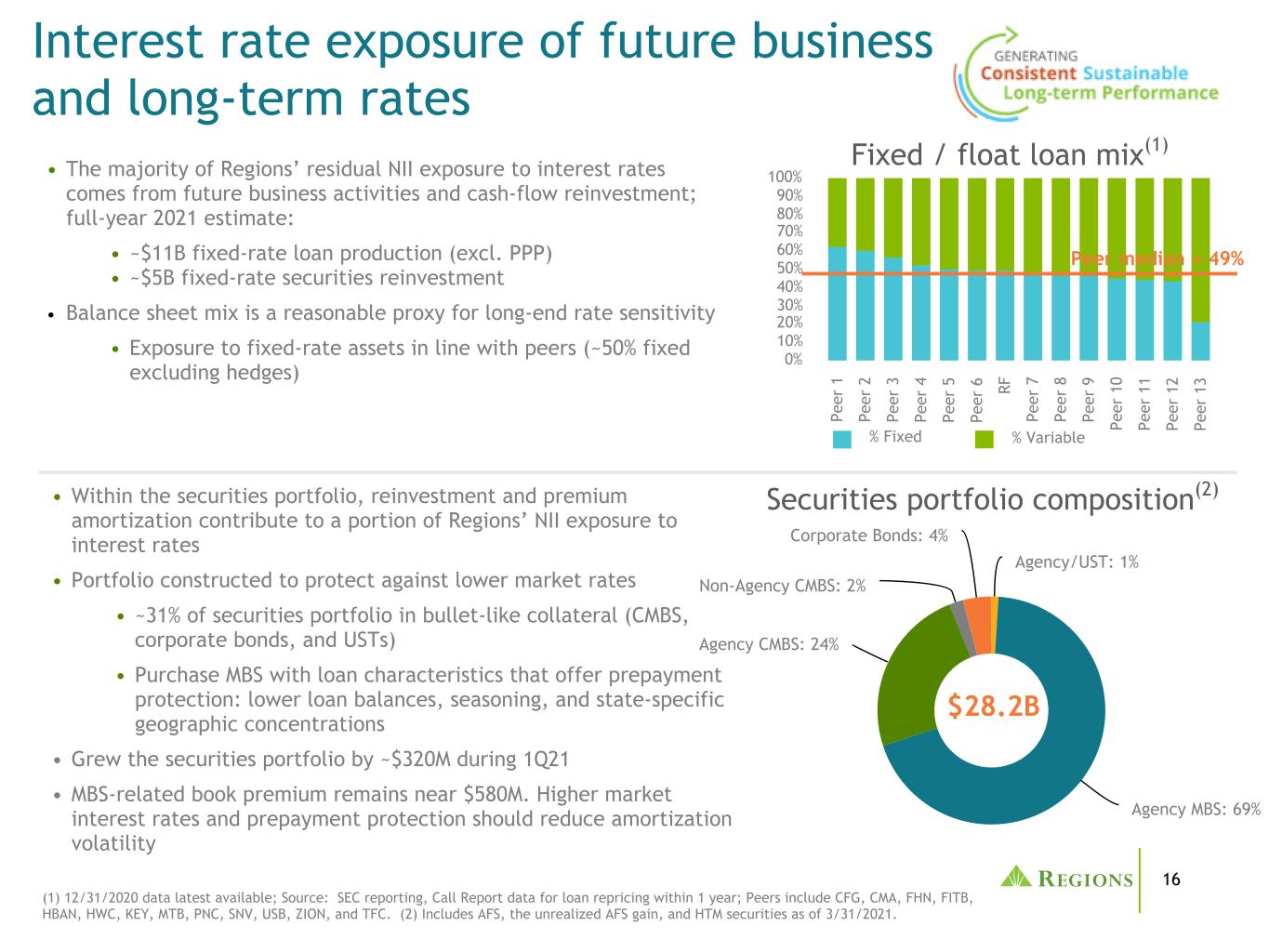
16 Agency/UST: 1% Agency MBS: 69% Agency CMBS: 24% Non-Agency CMBS: 2% Corporate Bonds: 4% Interest rate exposure of future business and long-term rates (1) 12/31/2020 data latest available; Source: SEC reporting, Call Report data for loan repricing within 1 year; Peers include CFG, CMA, FHN, FITB, HBAN, HWC, KEY, MTB, PNC, SNV, USB, ZION, and TFC. (2) Includes AFS, the unrealized AFS gain, and HTM securities as of 3/31/2021. • The majority of Regions’ residual NII exposure to interest rates comes from future business activities and cash-flow reinvestment; full-year 2021 estimate: • ~$11B fixed-rate loan production (excl. PPP) • ~$5B fixed-rate securities reinvestment • Balance sheet mix is a reasonable proxy for long-end rate sensitivity • Exposure to fixed-rate assets in line with peers (~50% fixed excluding hedges) Securities portfolio composition(2)• Within the securities portfolio, reinvestment and premium amortization contribute to a portion of Regions’ NII exposure to interest rates • Portfolio constructed to protect against lower market rates • ~31% of securities portfolio in bullet-like collateral (CMBS, corporate bonds, and USTs) • Purchase MBS with loan characteristics that offer prepayment protection: lower loan balances, seasoning, and state-specific geographic concentrations • Grew the securities portfolio by ~$320M during 1Q21 • MBS-related book premium remains near $580M. Higher market interest rates and prepayment protection should reduce amortization volatility $28.2B P e e r 1 P e e r 2 P e e r 3 P e e r 4 P e e r 5 P e e r 6 R F P e e r 7 P e e r 8 P e e r 9 P e e r 10 P e e r 11 P e e r 12 P e e r 13 0% 10% 20% 30% 40% 50% 60% 70% 80% 90% 100% Fixed / float loan mix(1) % Fixed % Variable Peer median = 49%
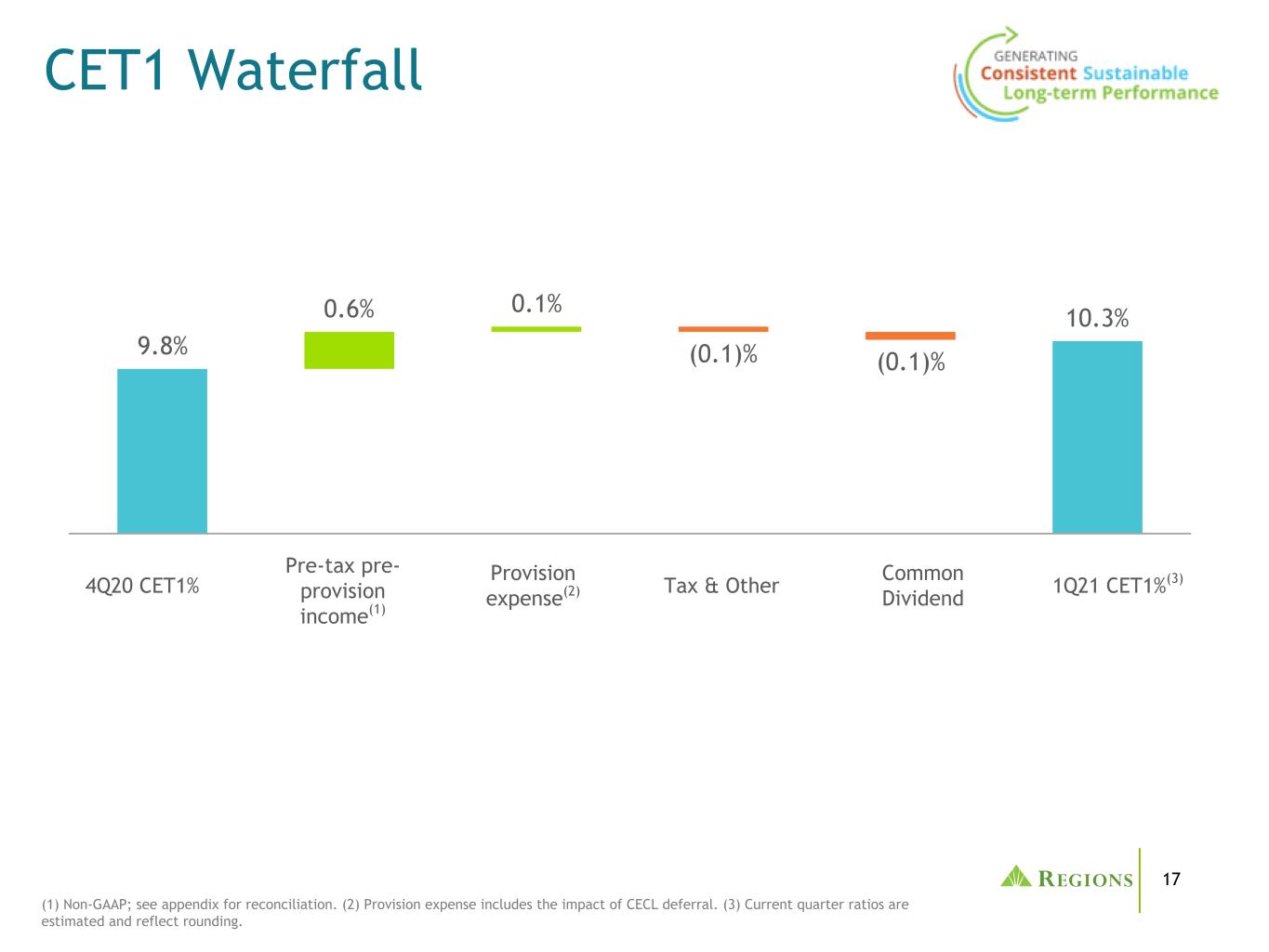
17 9.8% 0.6% 0.1% (0.1)% (0.1)% 10.3% CET1 Waterfall (1) Non-GAAP; see appendix for reconciliation. (2) Provision expense includes the impact of CECL deferral. (3) Current quarter ratios are estimated and reflect rounding. 4Q20 CET1% Pre-tax pre- provision income(1) Common Dividend 1Q21 CET1%(3) Provision expense(2) Tax & Other

18 Changes in Portfolio Risk & Balances $2,293 $(83) $(130) $(12) $2,068 Allowance for credit losses waterfall Changes in Economic Outlook Net Charge- Offs 3/31/2021 • 1Q ending allowance decreased $225M due to improvement in the economic outlook combined with stabilized credit performance and charge-offs • The benefits of the improving economic outlook were partially offset by increases to model adjustments due to continued uncertainty regarding the timing of full economic recovery and due to continued credit risk in certain portfolios. QoQ highlights ($ in millions) 12/31/2020
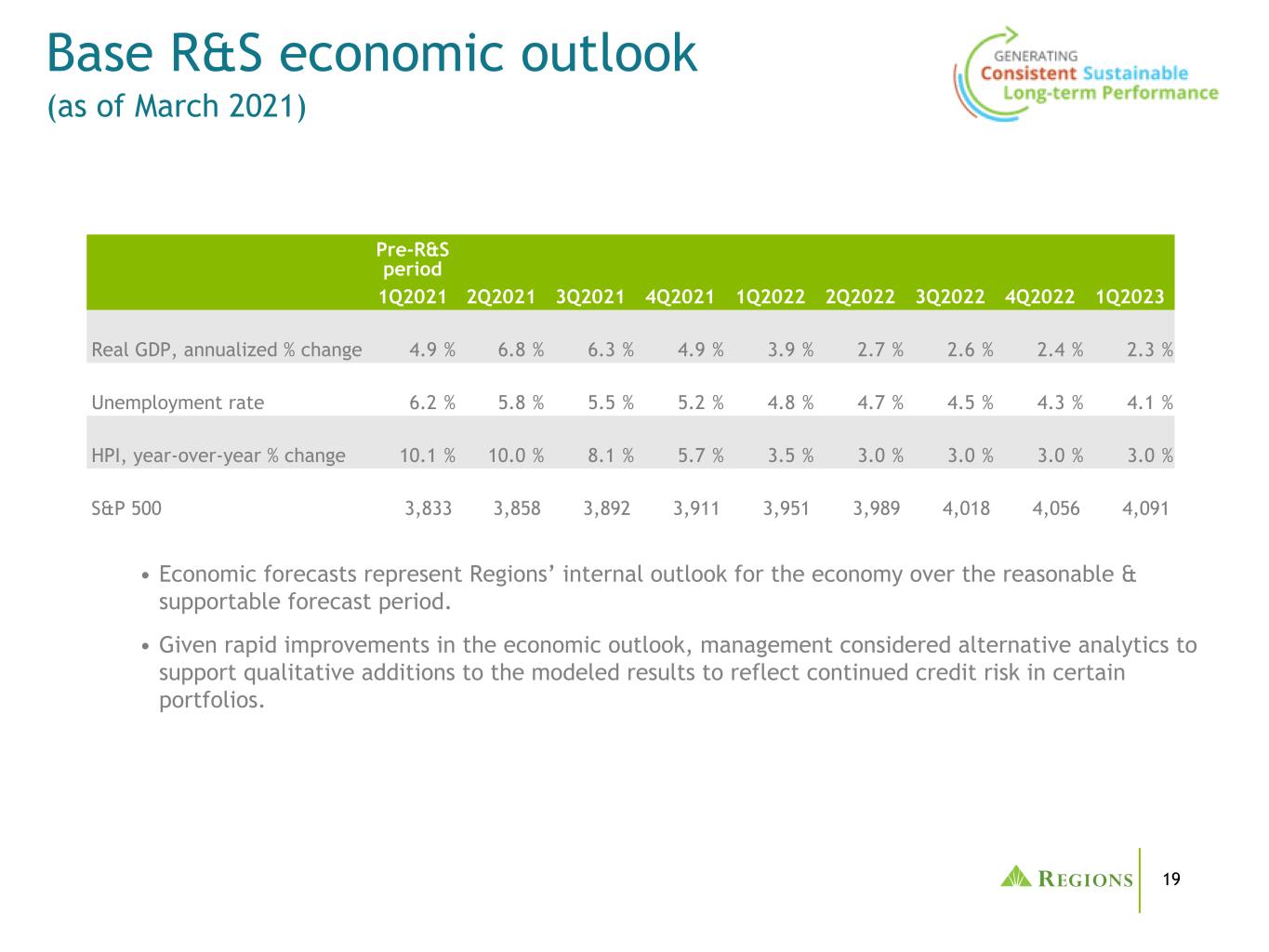
19 Pre-R&S period 1Q2021 2Q2021 3Q2021 4Q2021 1Q2022 2Q2022 3Q2022 4Q2022 1Q2023 Real GDP, annualized % change 4.9 % 6.8 % 6.3 % 4.9 % 3.9 % 2.7 % 2.6 % 2.4 % 2.3 % Unemployment rate 6.2 % 5.8 % 5.5 % 5.2 % 4.8 % 4.7 % 4.5 % 4.3 % 4.1 % HPI, year-over-year % change 10.1 % 10.0 % 8.1 % 5.7 % 3.5 % 3.0 % 3.0 % 3.0 % 3.0 % S&P 500 3,833 3,858 3,892 3,911 3,951 3,989 4,018 4,056 4,091 Base R&S economic outlook (as of March 2021) • Economic forecasts represent Regions’ internal outlook for the economy over the reasonable & supportable forecast period. • Given rapid improvements in the economic outlook, management considered alternative analytics to support qualitative additions to the modeled results to reflect continued credit risk in certain portfolios.
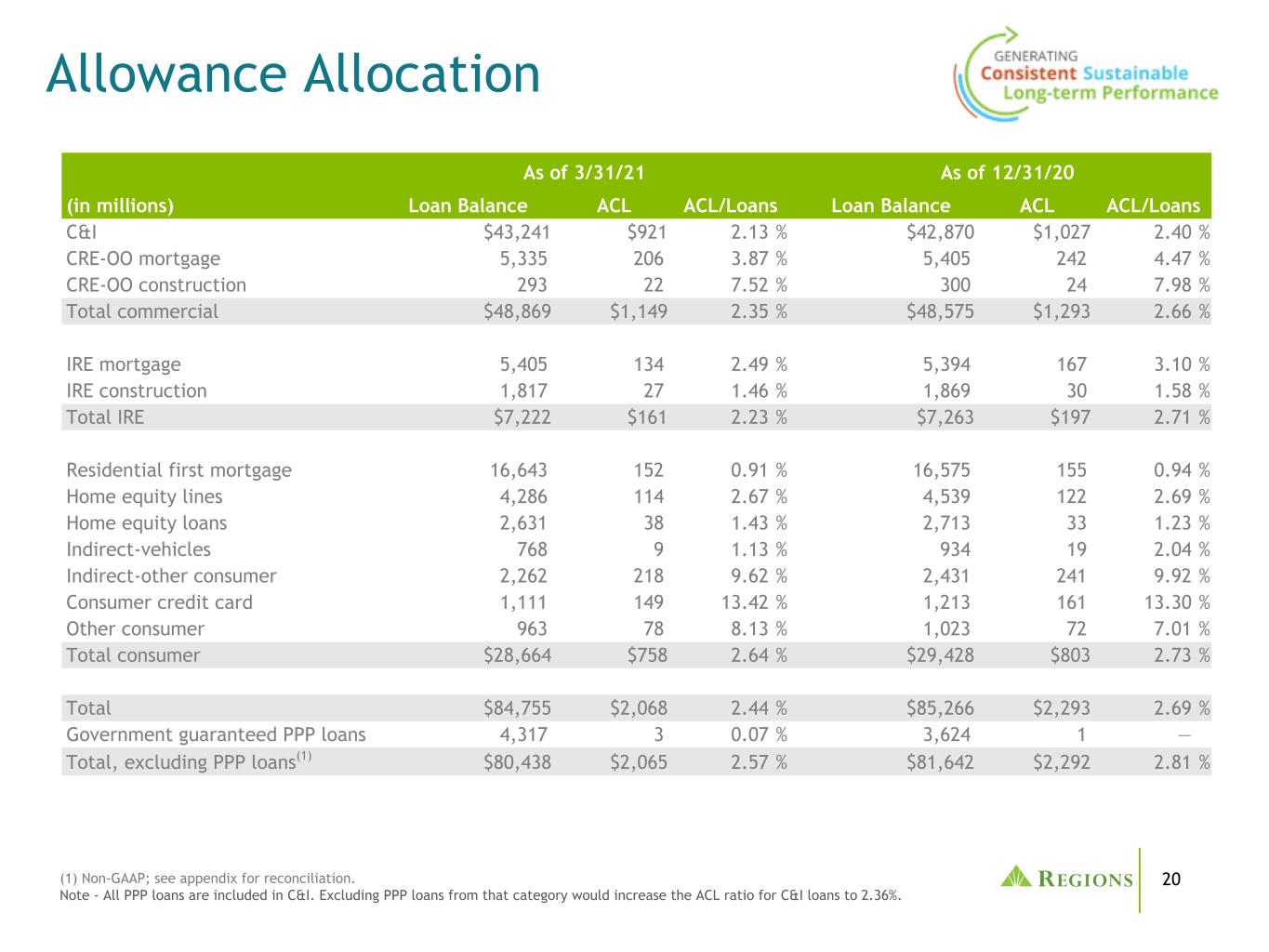
20 As of 3/31/21 As of 12/31/20 (in millions) Loan Balance ACL ACL/Loans Loan Balance ACL ACL/Loans C&I $43,241 $921 2.13 % $42,870 $1,027 2.40 % CRE-OO mortgage 5,335 206 3.87 % 5,405 242 4.47 % CRE-OO construction 293 22 7.52 % 300 24 7.98 % Total commercial $48,869 $1,149 2.35 % $48,575 $1,293 2.66 % IRE mortgage 5,405 134 2.49 % 5,394 167 3.10 % IRE construction 1,817 27 1.46 % 1,869 30 1.58 % Total IRE $7,222 $161 2.23 % $7,263 $197 2.71 % Residential first mortgage 16,643 152 0.91 % 16,575 155 0.94 % Home equity lines 4,286 114 2.67 % 4,539 122 2.69 % Home equity loans 2,631 38 1.43 % 2,713 33 1.23 % Indirect-vehicles 768 9 1.13 % 934 19 2.04 % Indirect-other consumer 2,262 218 9.62 % 2,431 241 9.92 % Consumer credit card 1,111 149 13.42 % 1,213 161 13.30 % Other consumer 963 78 8.13 % 1,023 72 7.01 % Total consumer $28,664 $758 2.64 % $29,428 $803 2.73 % Total $84,755 $2,068 2.44 % $85,266 $2,293 2.69 % Government guaranteed PPP loans 4,317 3 0.07 % 3,624 1 — Total, excluding PPP loans(1) $80,438 $2,065 2.57 % $81,642 $2,292 2.81 % Allowance Allocation (1) Non-GAAP; see appendix for reconciliation. Note - All PPP loans are included in C&I. Excluding PPP loans from that category would increase the ACL ratio for C&I loans to 2.36%.
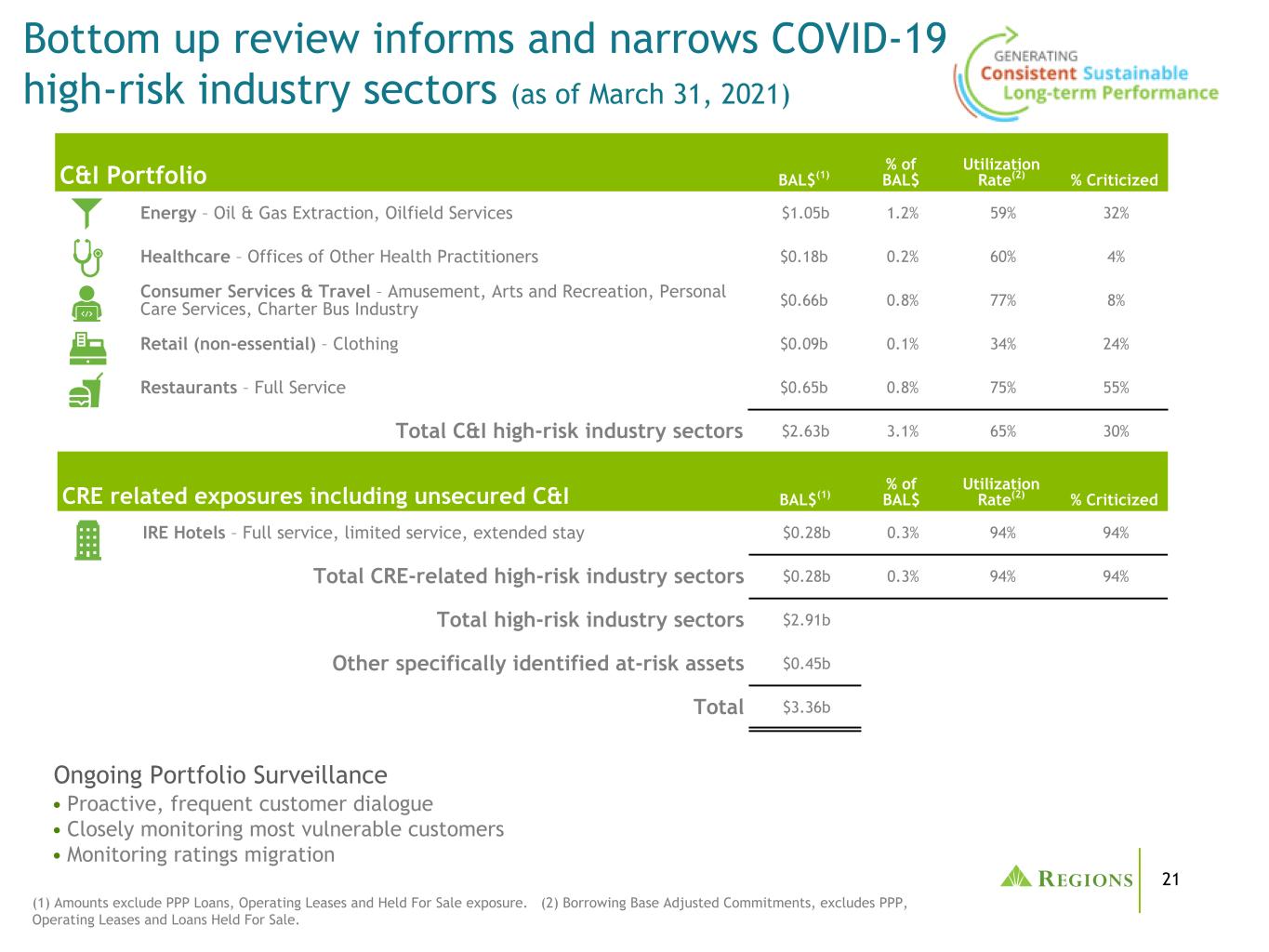
21 • Proactive, frequent customer dialogue • Closely monitoring most vulnerable customers • Monitoring ratings migration Bottom up review informs and narrows COVID-19 high-risk industry sectors (as of March 31, 2021) C&I Portfolio BAL$(1) % of BAL$ Utilization Rate(2) % Criticized Energy – Oil & Gas Extraction, Oilfield Services $1.05b 1.2% 59% 32% Healthcare – Offices of Other Health Practitioners $0.18b 0.2% 60% 4% Consumer Services & Travel – Amusement, Arts and Recreation, Personal Care Services, Charter Bus Industry $0.66b 0.8% 77% 8% Retail (non-essential) – Clothing $0.09b 0.1% 34% 24% Restaurants – Full Service $0.65b 0.8% 75% 55% Total C&I high-risk industry sectors $2.63b 3.1% 65% 30% CRE related exposures including unsecured C&I BAL$(1) % of BAL$ Utilization Rate(2) % Criticized IRE Hotels – Full service, limited service, extended stay $0.28b 0.3% 94% 94% Total CRE-related high-risk industry sectors $0.28b 0.3% 94% 94% Total high-risk industry sectors $2.91b Other specifically identified at-risk assets $0.45b Total $3.36b (1) Amounts exclude PPP Loans, Operating Leases and Held For Sale exposure. (2) Borrowing Base Adjusted Commitments, excludes PPP, Operating Leases and Loans Held For Sale. Ongoing Portfolio Surveillance
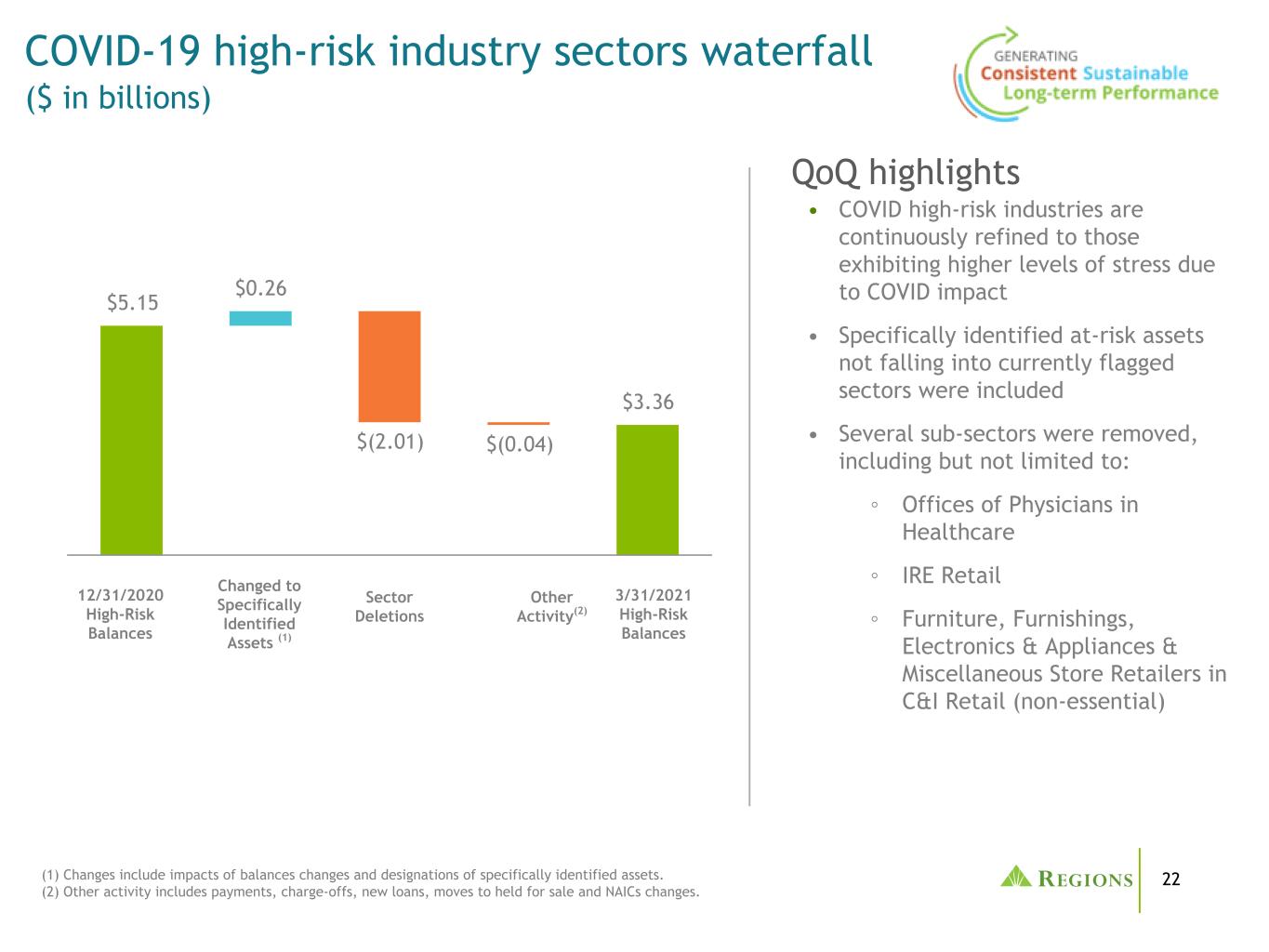
22 $5.15 $0.26 $(2.01) $(0.04) $3.36 COVID-19 high-risk industry sectors waterfall ($ in billions) Changed to Specifically Identified Assets (1) • COVID high-risk industries are continuously refined to those exhibiting higher levels of stress due to COVID impact • Specifically identified at-risk assets not falling into currently flagged sectors were included • Several sub-sectors were removed, including but not limited to: ◦ Offices of Physicians in Healthcare ◦ IRE Retail ◦ Furniture, Furnishings, Electronics & Appliances & Miscellaneous Store Retailers in C&I Retail (non-essential) QoQ highlights 12/31/2020 High-Risk Balances Other Activity(2) 3/31/2021 High-Risk Balances (1) Changes include impacts of balances changes and designations of specifically identified assets. (2) Other activity includes payments, charge-offs, new loans, moves to held for sale and NAICs changes. Sector Deletions
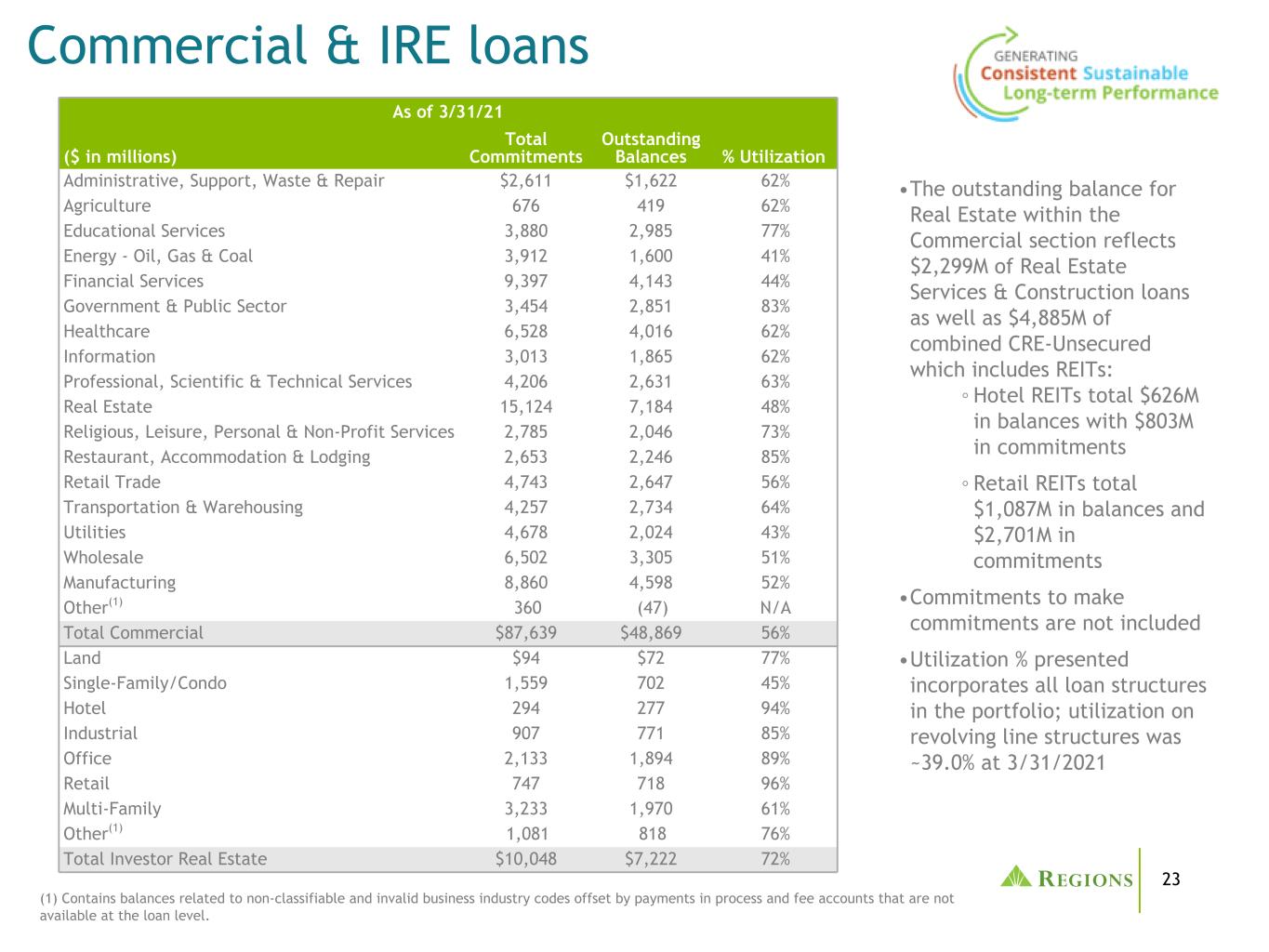
23 Commercial & IRE loans As of 3/31/21 ($ in millions) Total Commitments Outstanding Balances % Utilization Administrative, Support, Waste & Repair $2,611 $1,622 62% Agriculture 676 419 62% Educational Services 3,880 2,985 77% Energy - Oil, Gas & Coal 3,912 1,600 41% Financial Services 9,397 4,143 44% Government & Public Sector 3,454 2,851 83% Healthcare 6,528 4,016 62% Information 3,013 1,865 62% Professional, Scientific & Technical Services 4,206 2,631 63% Real Estate 15,124 7,184 48% Religious, Leisure, Personal & Non-Profit Services 2,785 2,046 73% Restaurant, Accommodation & Lodging 2,653 2,246 85% Retail Trade 4,743 2,647 56% Transportation & Warehousing 4,257 2,734 64% Utilities 4,678 2,024 43% Wholesale 6,502 3,305 51% Manufacturing 8,860 4,598 52% Other(1) 360 (47) N/A Total Commercial $87,639 $48,869 56% Land $94 $72 77% Single-Family/Condo 1,559 702 45% Hotel 294 277 94% Industrial 907 771 85% Office 2,133 1,894 89% Retail 747 718 96% Multi-Family 3,233 1,970 61% Other(1) 1,081 818 76% Total Investor Real Estate $10,048 $7,222 72% •The outstanding balance for Real Estate within the Commercial section reflects $2,299M of Real Estate Services & Construction loans as well as $4,885M of combined CRE-Unsecured which includes REITs: ◦ Hotel REITs total $626M in balances with $803M in commitments ◦ Retail REITs total $1,087M in balances and $2,701M in commitments •Commitments to make commitments are not included •Utilization % presented incorporates all loan structures in the portfolio; utilization on revolving line structures was ~39.0% at 3/31/2021 (1) Contains balances related to non-classifiable and invalid business industry codes offset by payments in process and fee accounts that are not available at the loan level.
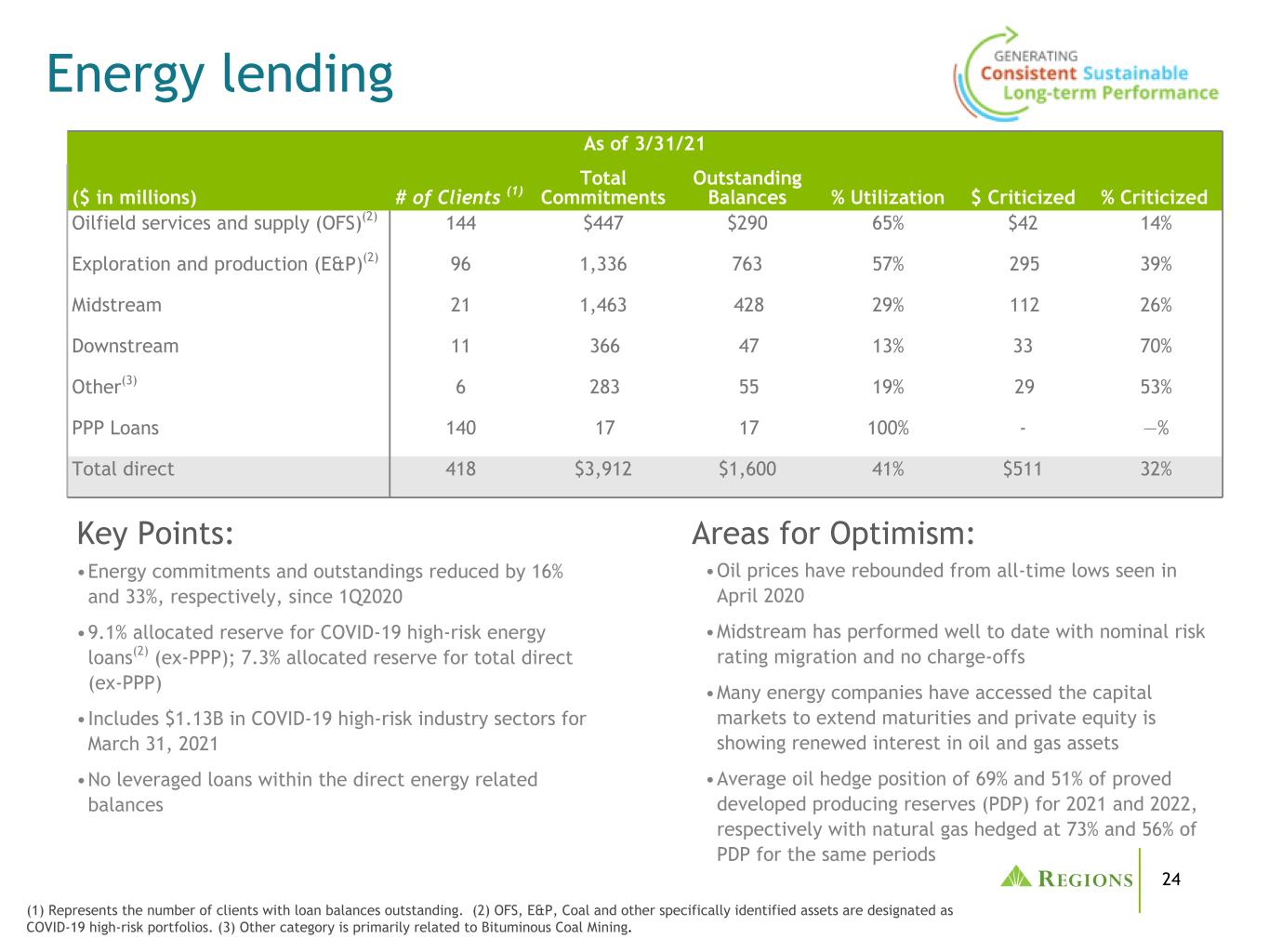
24 As of 3/31/21 ($ in millions) # of Clients (1) Total Commitments Outstanding Balances % Utilization $ Criticized % Criticized Oilfield services and supply (OFS)(2) 144 $447 $290 65% $42 14% Exploration and production (E&P)(2) 96 1,336 763 57% 295 39% Midstream 21 1,463 428 29% 112 26% Downstream 11 366 47 13% 33 70% Other(3) 6 283 55 19% 29 53% PPP Loans 140 17 17 100% - —% Total direct 418 $3,912 $1,600 41% $511 32% (1) Represents the number of clients with loan balances outstanding. (2) OFS, E&P, Coal and other specifically identified assets are designated as COVID-19 high-risk portfolios. (3) Other category is primarily related to Bituminous Coal Mining. Energy lending •Oil prices have rebounded from all-time lows seen in April 2020 •Midstream has performed well to date with nominal risk rating migration and no charge-offs •Many energy companies have accessed the capital markets to extend maturities and private equity is showing renewed interest in oil and gas assets •Average oil hedge position of 69% and 51% of proved developed producing reserves (PDP) for 2021 and 2022, respectively with natural gas hedged at 73% and 56% of PDP for the same periods •Energy commitments and outstandings reduced by 16% and 33%, respectively, since 1Q2020 •9.1% allocated reserve for COVID-19 high-risk energy loans(2) (ex-PPP); 7.3% allocated reserve for total direct (ex-PPP) •Includes $1.13B in COVID-19 high-risk industry sectors for March 31, 2021 •No leveraged loans within the direct energy related balances Key Points: Areas for Optimism:

25 $ (M ill io ns ) 1Q2015 1Q2021 E& P Oil fie ld Se rvi ce s Mi ds tre am Do wn str ea m Ot he r PP P L oa ns $0 $300 $600 $900 $1,200 $1,500 Energy lending (continued) Balances by Category Gross Losses *Other Losses include losses to MLP funds as well as losses related to coal. $ (M ill io ns ) $0.0 $28.5 $36.7 $75.1 $33.0 $6.0 $135.9 $0.2 E&P Oilfield Services Midstream Downstream Other* 20 14 20 15 20 16 20 17 20 18 20 19 20 20 20 21 $0 $20 $40 $60 $80 $100 $120 $140 $ (M ill io ns ) Total Commitments Outstanding Balances 1Q 20 20 4Q 20 20 1Q 20 21 $0 $1,000 $2,000 $3,000 $4,000 $5,000 Balance Trend
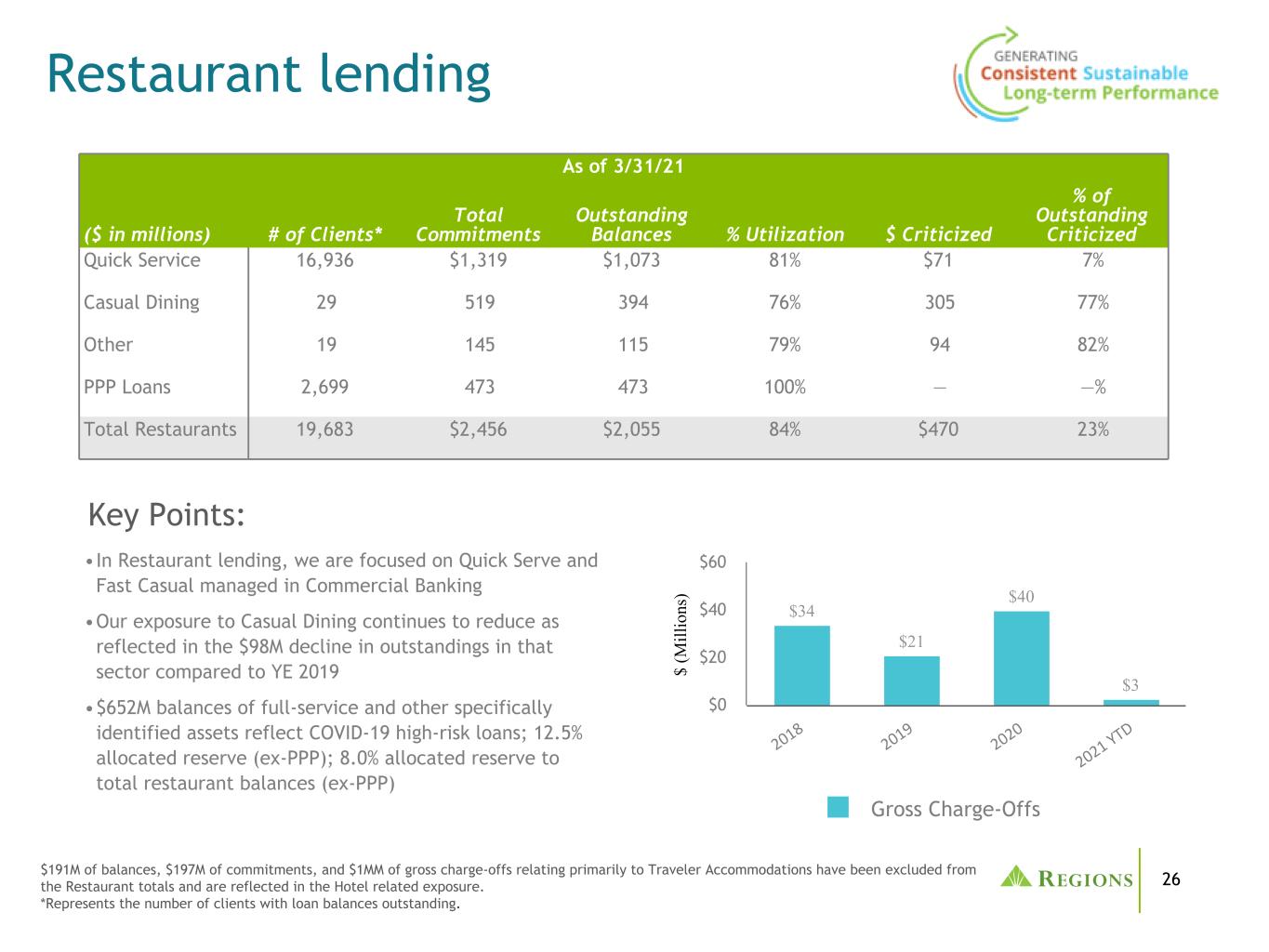
26 As of 3/31/21 ($ in millions) # of Clients* Total Commitments Outstanding Balances % Utilization $ Criticized % of Outstanding Criticized Quick Service 16,936 $1,319 $1,073 81% $71 7% Casual Dining 29 519 394 76% 305 77% Other 19 145 115 79% 94 82% PPP Loans 2,699 473 473 100% — —% Total Restaurants 19,683 $2,456 $2,055 84% $470 23% Restaurant lending •In Restaurant lending, we are focused on Quick Serve and Fast Casual managed in Commercial Banking •Our exposure to Casual Dining continues to reduce as reflected in the $98M decline in outstandings in that sector compared to YE 2019 •$652M balances of full-service and other specifically identified assets reflect COVID-19 high-risk loans; 12.5% allocated reserve (ex-PPP); 8.0% allocated reserve to total restaurant balances (ex-PPP) $191M of balances, $197M of commitments, and $1MM of gross charge-offs relating primarily to Traveler Accommodations have been excluded from the Restaurant totals and are reflected in the Hotel related exposure. *Represents the number of clients with loan balances outstanding. Key Points: $ (M ill io ns ) $34 $21 $40 $3 Gross Charge-Offs 20 18 20 19 20 20 20 21 YT D $0 $20 $40 $60
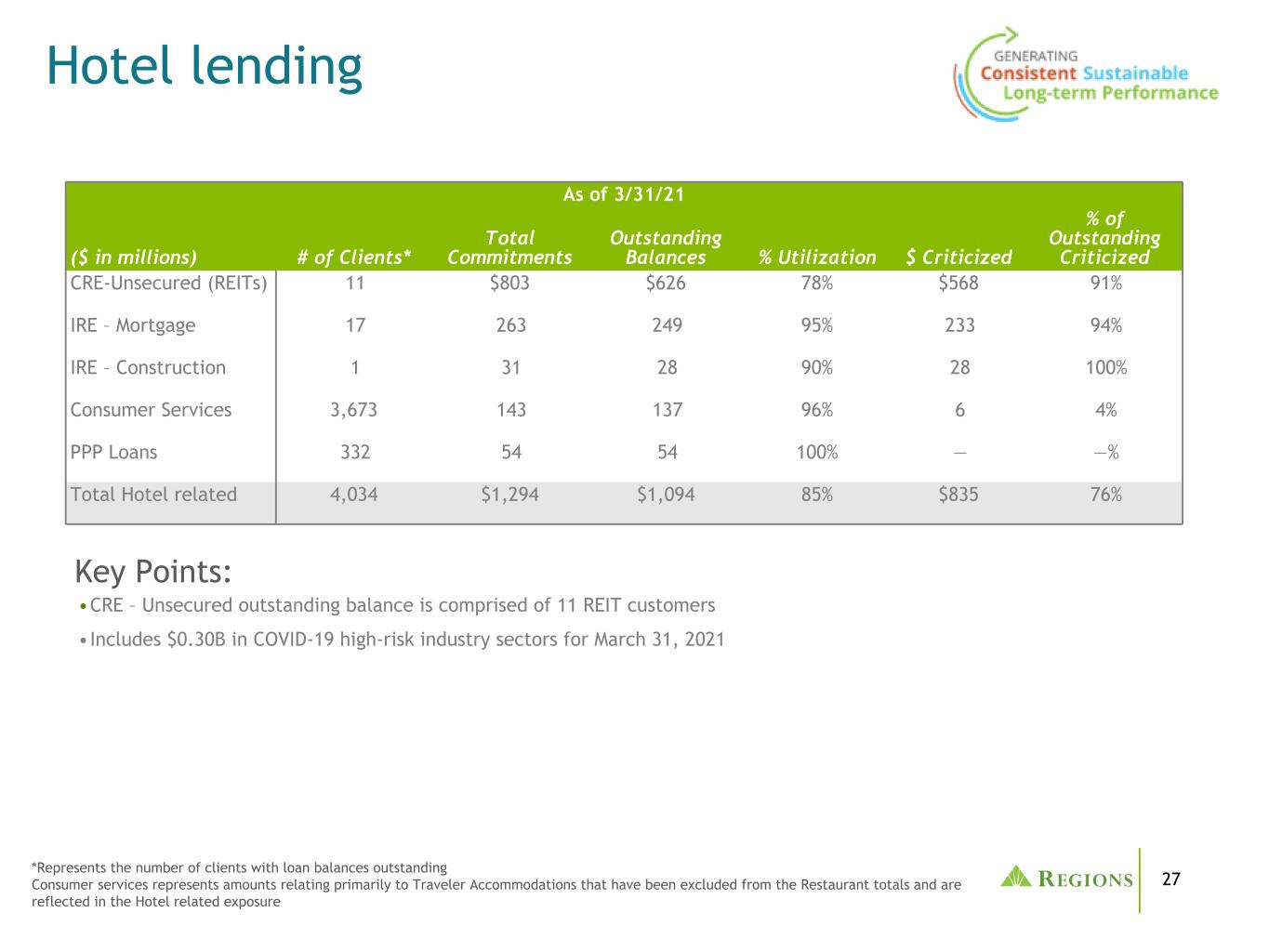
27 As of 3/31/21 ($ in millions) # of Clients* Total Commitments Outstanding Balances % Utilization $ Criticized % of Outstanding Criticized CRE-Unsecured (REITs) 11 $803 $626 78% $568 91% IRE – Mortgage 17 263 249 95% 233 94% IRE – Construction 1 31 28 90% 28 100% Consumer Services 3,673 143 137 96% 6 4% PPP Loans 332 54 54 100% — —% Total Hotel related 4,034 $1,294 $1,094 85% $835 76% Hotel lending •CRE – Unsecured outstanding balance is comprised of 11 REIT customers •Includes $0.30B in COVID-19 high-risk industry sectors for March 31, 2021 *Represents the number of clients with loan balances outstanding Consumer services represents amounts relating primarily to Traveler Accommodations that have been excluded from the Restaurant totals and are reflected in the Hotel related exposure Key Points:
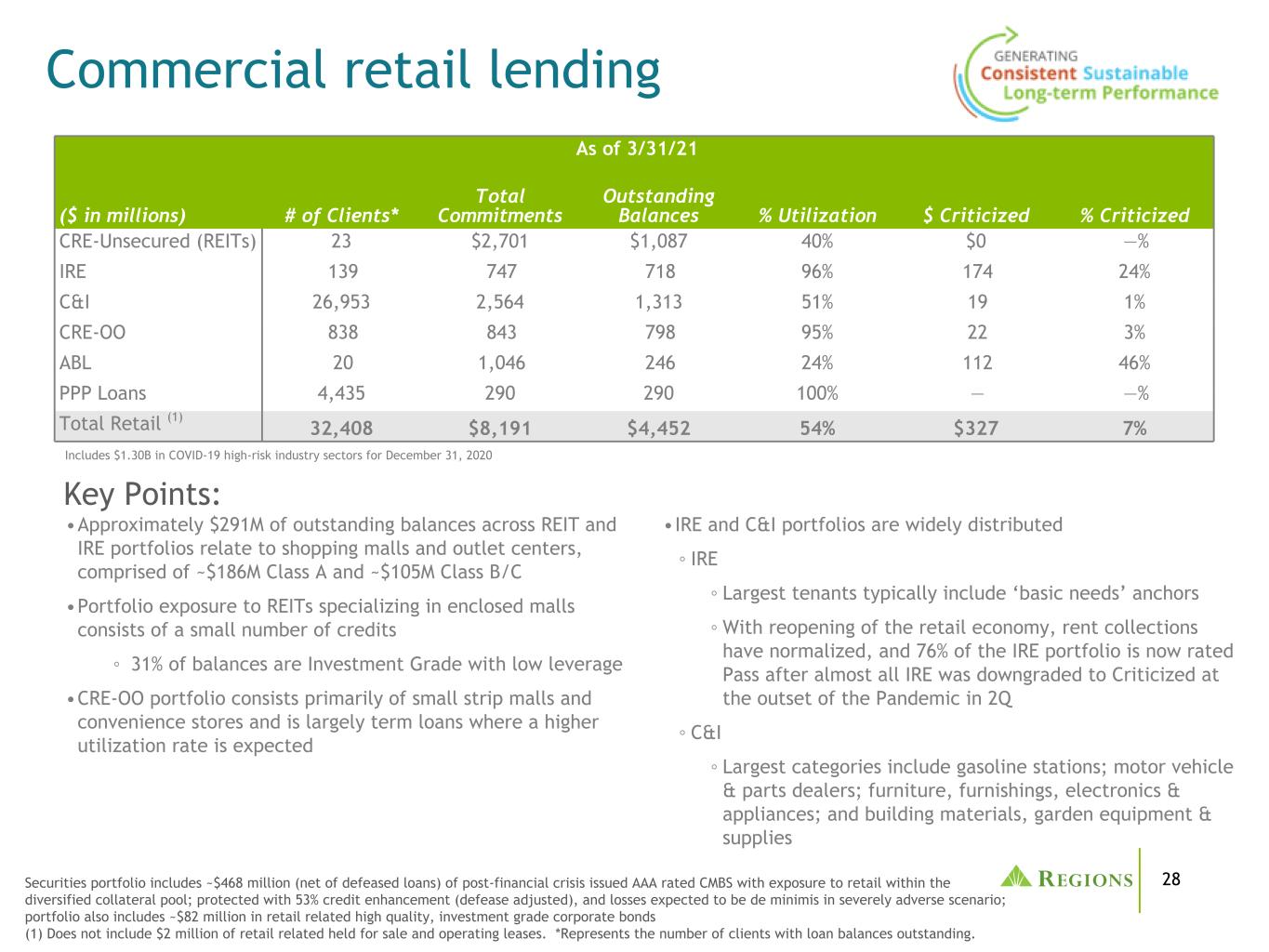
28 Commercial retail lending As of 3/31/21 ($ in millions) # of Clients* Total Commitments Outstanding Balances % Utilization $ Criticized % Criticized CRE-Unsecured (REITs) 23 $2,701 $1,087 40% $0 —% IRE 139 747 718 96% 174 24% C&I 26,953 2,564 1,313 51% 19 1% CRE-OO 838 843 798 95% 22 3% ABL 20 1,046 246 24% 112 46% PPP Loans 4,435 290 290 100% — —% Total Retail (1) 32,408 $8,191 $4,452 54% $327 7% •IRE and C&I portfolios are widely distributed ◦ IRE ◦ Largest tenants typically include ‘basic needs’ anchors ◦ With reopening of the retail economy, rent collections have normalized, and 76% of the IRE portfolio is now rated Pass after almost all IRE was downgraded to Criticized at the outset of the Pandemic in 2Q ◦ C&I ◦ Largest categories include gasoline stations; motor vehicle & parts dealers; furniture, furnishings, electronics & appliances; and building materials, garden equipment & supplies Securities portfolio includes ~$468 million (net of defeased loans) of post-financial crisis issued AAA rated CMBS with exposure to retail within the diversified collateral pool; protected with 53% credit enhancement (defease adjusted), and losses expected to be de minimis in severely adverse scenario; portfolio also includes ~$82 million in retail related high quality, investment grade corporate bonds (1) Does not include $2 million of retail related held for sale and operating leases. *Represents the number of clients with loan balances outstanding. •Approximately $291M of outstanding balances across REIT and IRE portfolios relate to shopping malls and outlet centers, comprised of ~$186M Class A and ~$105M Class B/C •Portfolio exposure to REITs specializing in enclosed malls consists of a small number of credits ◦ 31% of balances are Investment Grade with low leverage •CRE-OO portfolio consists primarily of small strip malls and convenience stores and is largely term loans where a higher utilization rate is expected Includes $1.30B in COVID-19 high-risk industry sectors for December 31, 2020 Key Points:
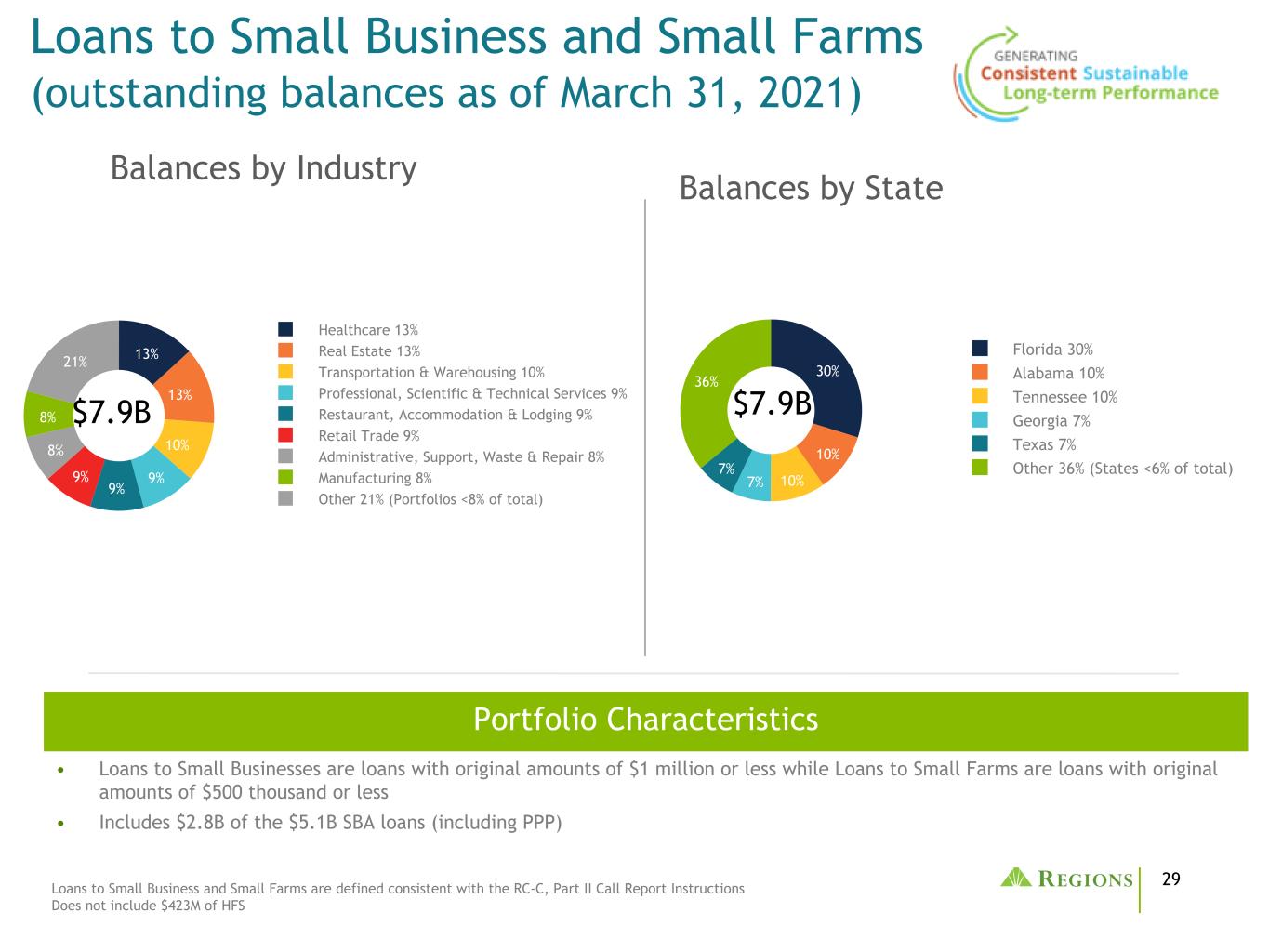
29 13% 13% 10% 9% 9% 9% 8% 8% 21% Healthcare 13% Real Estate 13% Transportation & Warehousing 10% Professional, Scientific & Technical Services 9% Restaurant, Accommodation & Lodging 9% Retail Trade 9% Administrative, Support, Waste & Repair 8% Manufacturing 8% Other 21% (Portfolios <8% of total) 30% 10% 10%7% 7% 36% Florida 30% Alabama 10% Tennessee 10% Georgia 7% Texas 7% Other 36% (States <6% of total) Balances by Industry Loans to Small Business and Small Farms (outstanding balances as of March 31, 2021) Loans to Small Business and Small Farms are defined consistent with the RC-C, Part II Call Report Instructions Does not include $423M of HFS • Loans to Small Businesses are loans with original amounts of $1 million or less while Loans to Small Farms are loans with original amounts of $500 thousand or less • Includes $2.8B of the $5.1B SBA loans (including PPP) Portfolio Characteristics $7.9B Balances by State $7.9B
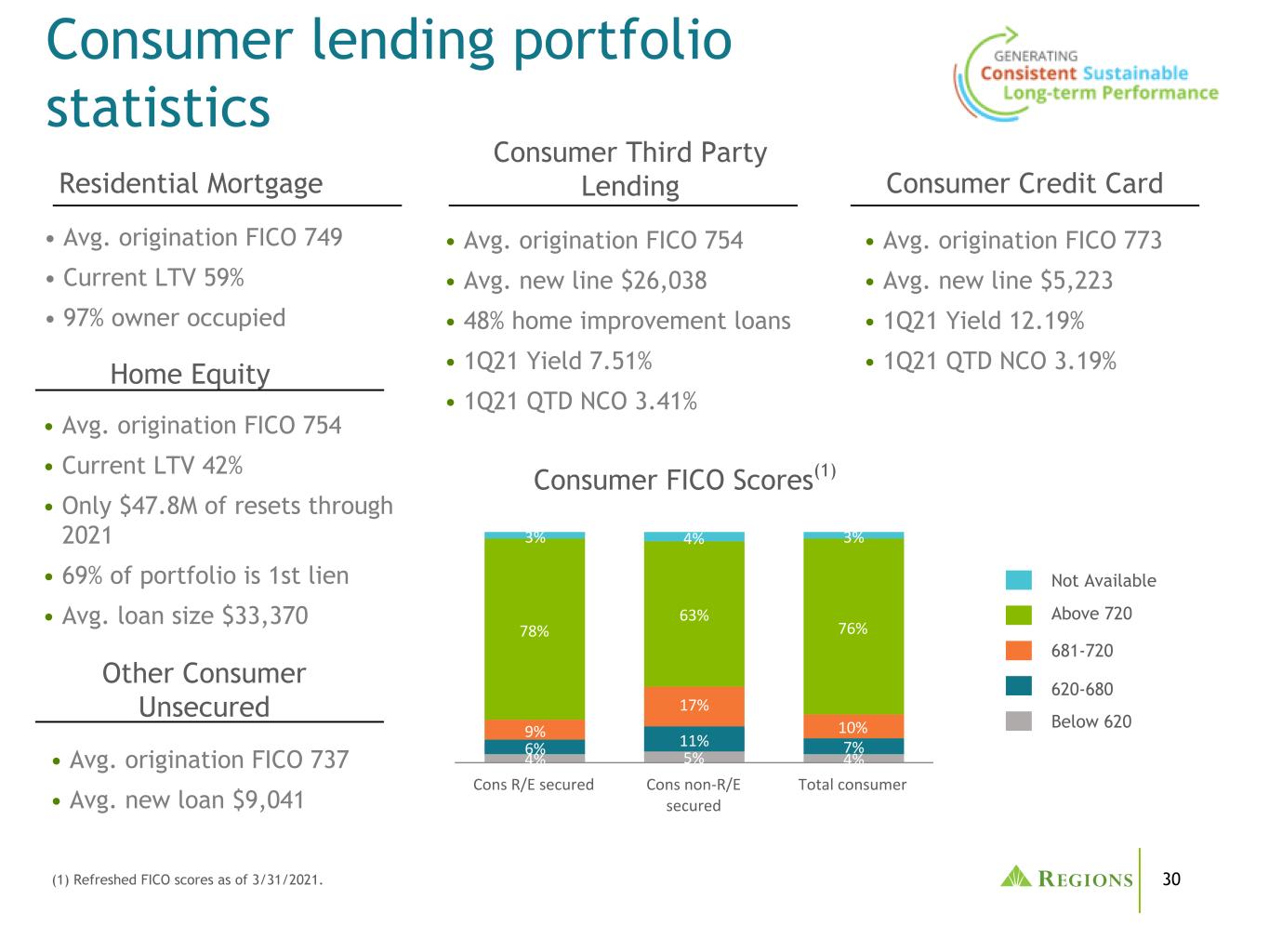
30 Consumer lending portfolio statistics Residential Mortgage • Avg. origination FICO 749 • Current LTV 59% • 97% owner occupied Home Equity • Avg. origination FICO 754 • Current LTV 42% • Only $47.8M of resets through 2021 • 69% of portfolio is 1st lien • Avg. loan size $33,370 Other Consumer Unsecured • Avg. origination FICO 737 • Avg. new loan $9,041 Consumer Third Party Lending • Avg. origination FICO 754 • Avg. new line $26,038 • 48% home improvement loans • 1Q21 Yield 7.51% • 1Q21 QTD NCO 3.41% Consumer Credit Card • Avg. origination FICO 773 • Avg. new line $5,223 • 1Q21 Yield 12.19% • 1Q21 QTD NCO 3.19% 4% 5% 4% 6% 11% 7% 9% 17% 10% 78% 63% 76% 3% 4% 3% Cons R/E secured Cons non-R/E secured Total consumer Not Available Above 720 620-680 Below 620 681-720 Consumer FICO Scores(1) (1) Refreshed FICO scores as of 3/31/2021.
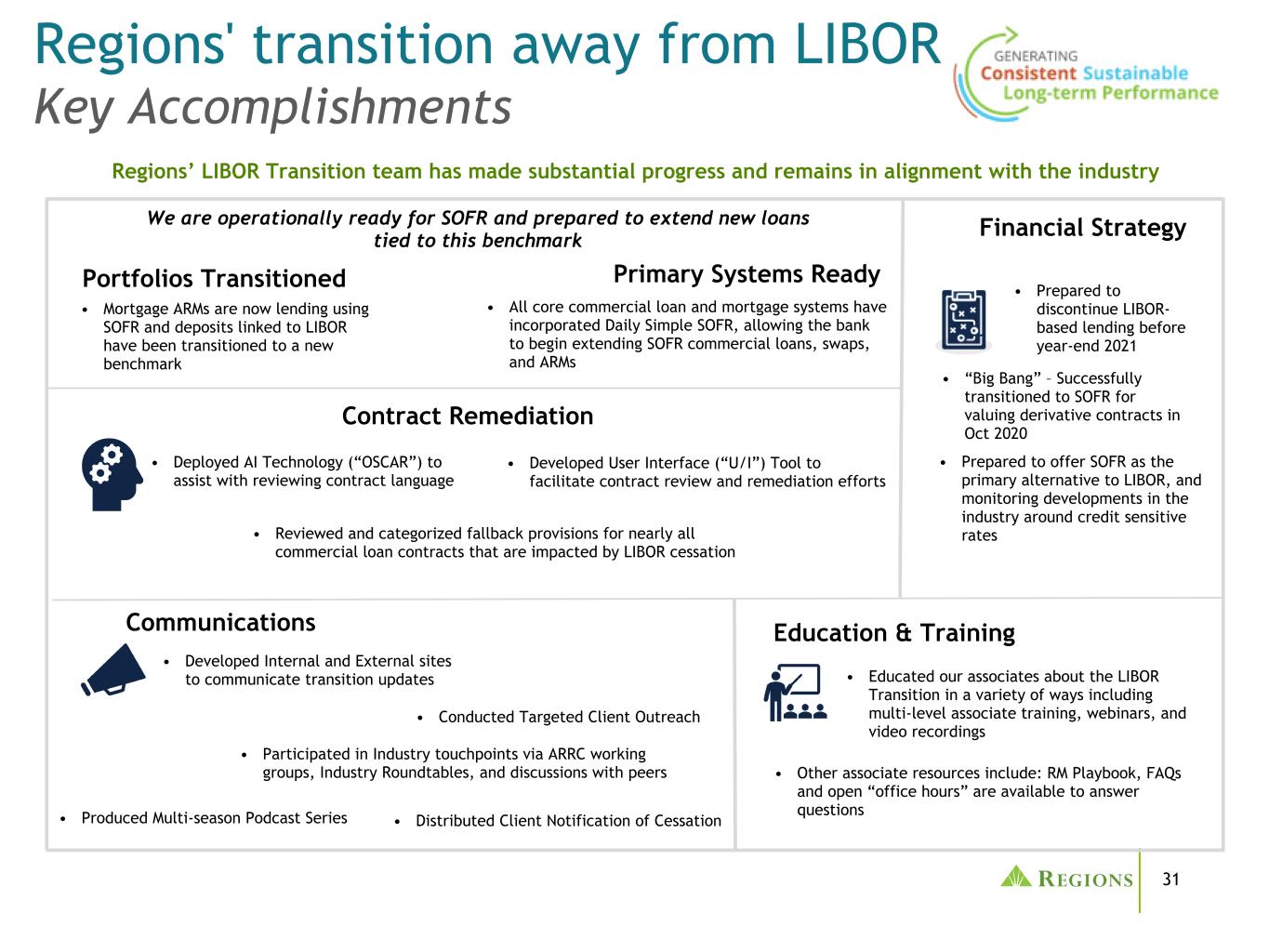
31 Regions' transition away from LIBOR Key Accomplishments • B We are operationally ready for SOFR and prepared to extend new loans tied to this benchmark • Mortgage ARMs are now lending using SOFR and deposits linked to LIBOR have been transitioned to a new benchmark Portfolios Transitioned • All core commercial loan and mortgage systems have incorporated Daily Simple SOFR, allowing the bank to begin extending SOFR commercial loans, swaps, and ARMs Primary Systems Ready • Prepared to discontinue LIBOR- based lending before year-end 2021 Financial Strategy • $.8M • Developed User Interface (“U/I”) Tool to facilitate contract review and remediation efforts • Educated our associates about the LIBOR Transition in a variety of ways including multi-level associate training, webinars, and video recordings Education & Training • Developed Internal and External sites to communicate transition updates • Participated in Industry touchpoints via ARRC working groups, Industry Roundtables, and discussions with peers Regions’ LIBOR Transition team has made substantial progress and remains in alignment with the industry Communications • Conducted Targeted Client Outreach • Distributed Client Notification of Cessation• Produced Multi-season Podcast Series • Prepared to offer SOFR as the primary alternative to LIBOR, and monitoring developments in the industry around credit sensitive rates Contract Remediation • Deployed AI Technology (“OSCAR”) to assist with reviewing contract language • “Big Bang” – Successfully transitioned to SOFR for valuing derivative contracts in Oct 2020 • Reviewed and categorized fallback provisions for nearly all commercial loan contracts that are impacted by LIBOR cessation • Other associate resources include: RM Playbook, FAQs and open “office hours” are available to answer questions
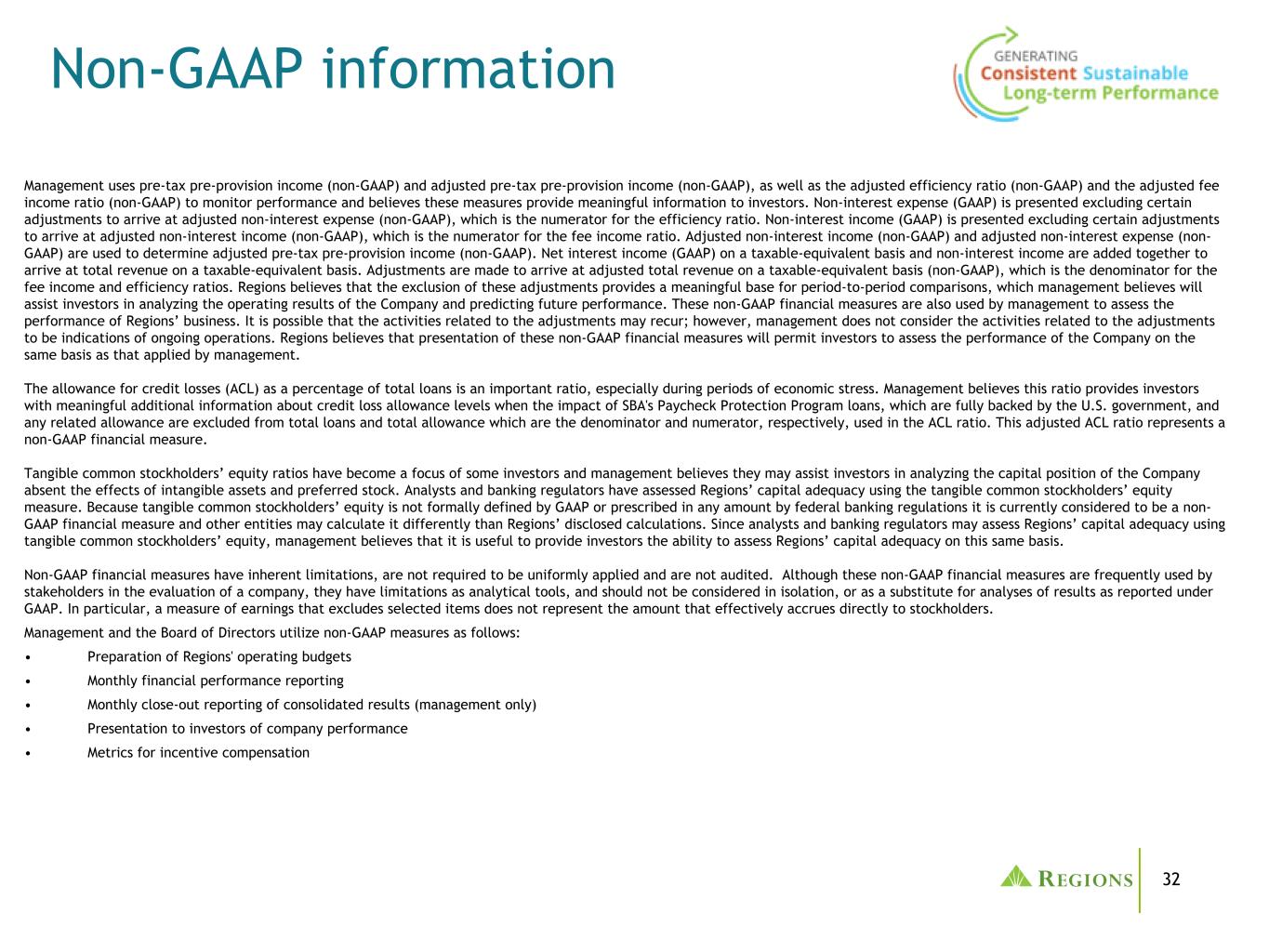
32 Management uses pre-tax pre-provision income (non-GAAP) and adjusted pre-tax pre-provision income (non-GAAP), as well as the adjusted efficiency ratio (non-GAAP) and the adjusted fee income ratio (non-GAAP) to monitor performance and believes these measures provide meaningful information to investors. Non-interest expense (GAAP) is presented excluding certain adjustments to arrive at adjusted non-interest expense (non-GAAP), which is the numerator for the efficiency ratio. Non-interest income (GAAP) is presented excluding certain adjustments to arrive at adjusted non-interest income (non-GAAP), which is the numerator for the fee income ratio. Adjusted non-interest income (non-GAAP) and adjusted non-interest expense (non- GAAP) are used to determine adjusted pre-tax pre-provision income (non-GAAP). Net interest income (GAAP) on a taxable-equivalent basis and non-interest income are added together to arrive at total revenue on a taxable-equivalent basis. Adjustments are made to arrive at adjusted total revenue on a taxable-equivalent basis (non-GAAP), which is the denominator for the fee income and efficiency ratios. Regions believes that the exclusion of these adjustments provides a meaningful base for period-to-period comparisons, which management believes will assist investors in analyzing the operating results of the Company and predicting future performance. These non-GAAP financial measures are also used by management to assess the performance of Regions’ business. It is possible that the activities related to the adjustments may recur; however, management does not consider the activities related to the adjustments to be indications of ongoing operations. Regions believes that presentation of these non-GAAP financial measures will permit investors to assess the performance of the Company on the same basis as that applied by management. The allowance for credit losses (ACL) as a percentage of total loans is an important ratio, especially during periods of economic stress. Management believes this ratio provides investors with meaningful additional information about credit loss allowance levels when the impact of SBA's Paycheck Protection Program loans, which are fully backed by the U.S. government, and any related allowance are excluded from total loans and total allowance which are the denominator and numerator, respectively, used in the ACL ratio. This adjusted ACL ratio represents a non-GAAP financial measure. Tangible common stockholders’ equity ratios have become a focus of some investors and management believes they may assist investors in analyzing the capital position of the Company absent the effects of intangible assets and preferred stock. Analysts and banking regulators have assessed Regions’ capital adequacy using the tangible common stockholders’ equity measure. Because tangible common stockholders’ equity is not formally defined by GAAP or prescribed in any amount by federal banking regulations it is currently considered to be a non- GAAP financial measure and other entities may calculate it differently than Regions’ disclosed calculations. Since analysts and banking regulators may assess Regions’ capital adequacy using tangible common stockholders’ equity, management believes that it is useful to provide investors the ability to assess Regions’ capital adequacy on this same basis. Non-GAAP financial measures have inherent limitations, are not required to be uniformly applied and are not audited. Although these non-GAAP financial measures are frequently used by stakeholders in the evaluation of a company, they have limitations as analytical tools, and should not be considered in isolation, or as a substitute for analyses of results as reported under GAAP. In particular, a measure of earnings that excludes selected items does not represent the amount that effectively accrues directly to stockholders. Management and the Board of Directors utilize non-GAAP measures as follows: • Preparation of Regions' operating budgets • Monthly financial performance reporting • Monthly close-out reporting of consolidated results (management only) • Presentation to investors of company performance • Metrics for incentive compensation Non-GAAP information

33 Non-GAAP reconciliation: adjusted net interest margin Quarter-ended 3/31/2021 12/31/2020 9/30/2020 6/30/2020 3/31/2020 Net interest margin (FTE) (GAAP) 3.02 % 3.13 % 3.13 % 3.19 % 3.44 % Impact of SBA PPP loans (0.04) % (0.07) % 0.01 % 0.02 % NM Impact of excess cash 0.42 % 0.34 % 0.27 % 0.15 % NM Adjusted net interest margin (FTE) (non-GAAP) 3.40 % 3.40 % 3.41 % 3.36 % 3.44 % NM - Not Meaningful
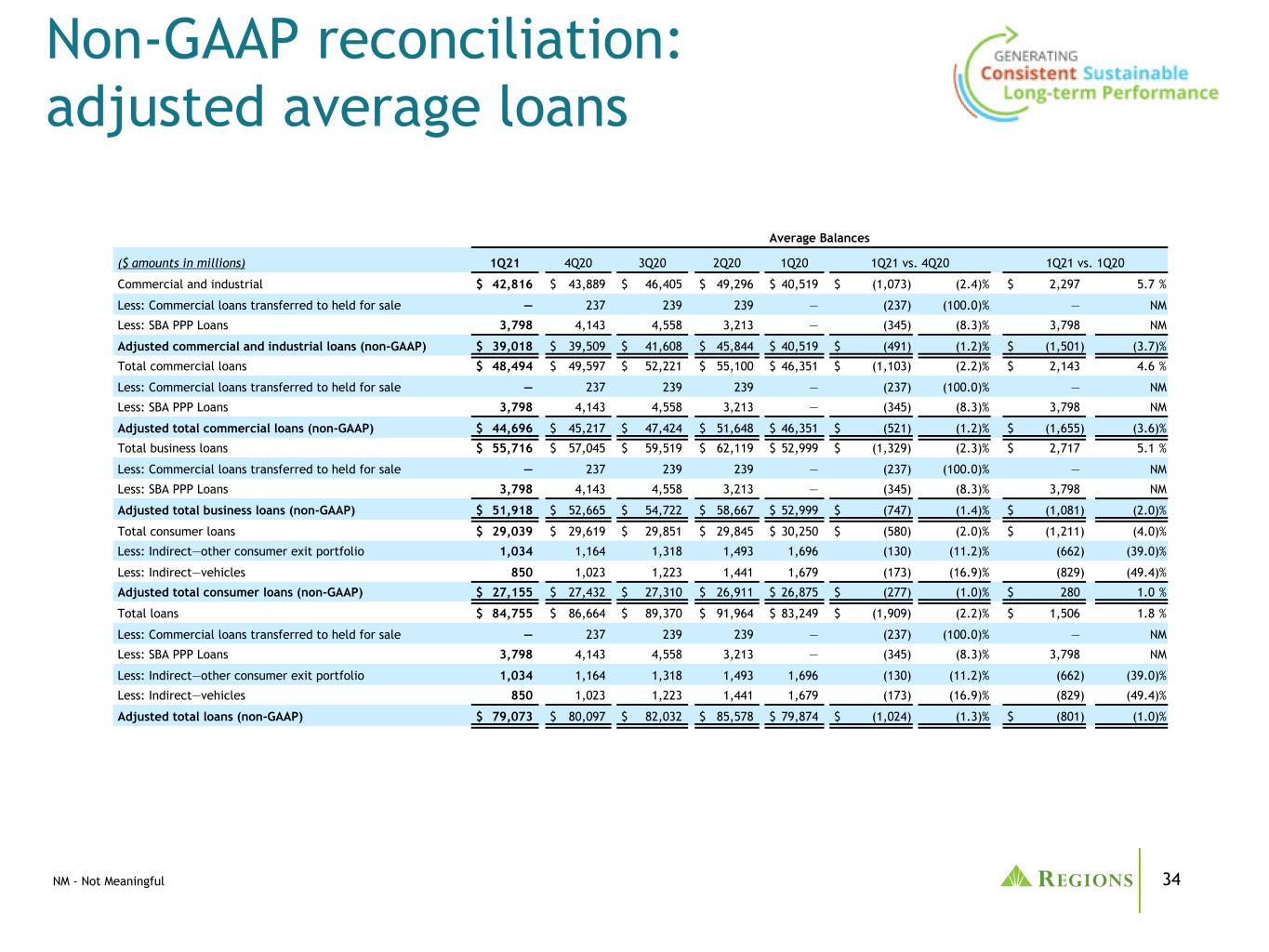
34 Non-GAAP reconciliation: adjusted average loans Average Balances ($ amounts in millions) 1Q21 4Q20 3Q20 2Q20 1Q20 1Q21 vs. 4Q20 1Q21 vs. 1Q20 Commercial and industrial $ 42,816 $ 43,889 $ 46,405 $ 49,296 $ 40,519 $ (1,073) (2.4) % $ 2,297 5.7 % Less: Commercial loans transferred to held for sale — 237 239 239 — (237) (100.0) % — NM Less: SBA PPP Loans 3,798 4,143 4,558 3,213 — (345) (8.3) % 3,798 NM Adjusted commercial and industrial loans (non-GAAP) $ 39,018 $ 39,509 $ 41,608 $ 45,844 $ 40,519 $ (491) (1.2) % $ (1,501) (3.7) % Total commercial loans $ 48,494 $ 49,597 $ 52,221 $ 55,100 $ 46,351 $ (1,103) (2.2) % $ 2,143 4.6 % Less: Commercial loans transferred to held for sale — 237 239 239 — (237) (100.0) % — NM Less: SBA PPP Loans 3,798 4,143 4,558 3,213 — (345) (8.3) % 3,798 NM Adjusted total commercial loans (non-GAAP) $ 44,696 $ 45,217 $ 47,424 $ 51,648 $ 46,351 $ (521) (1.2) % $ (1,655) (3.6) % Total business loans $ 55,716 $ 57,045 $ 59,519 $ 62,119 $ 52,999 $ (1,329) (2.3) % $ 2,717 5.1 % Less: Commercial loans transferred to held for sale — 237 239 239 — (237) (100.0) % — NM Less: SBA PPP Loans 3,798 4,143 4,558 3,213 — (345) (8.3) % 3,798 NM Adjusted total business loans (non-GAAP) $ 51,918 $ 52,665 $ 54,722 $ 58,667 $ 52,999 $ (747) (1.4) % $ (1,081) (2.0) % Total consumer loans $ 29,039 $ 29,619 $ 29,851 $ 29,845 $ 30,250 $ (580) (2.0) % $ (1,211) (4.0) % Less: Indirect—other consumer exit portfolio 1,034 1,164 1,318 1,493 1,696 (130) (11.2) % (662) (39.0) % Less: Indirect—vehicles 850 1,023 1,223 1,441 1,679 (173) (16.9) % (829) (49.4) % Adjusted total consumer loans (non-GAAP) $ 27,155 $ 27,432 $ 27,310 $ 26,911 $ 26,875 $ (277) (1.0) % $ 280 1.0 % Total loans $ 84,755 $ 86,664 $ 89,370 $ 91,964 $ 83,249 $ (1,909) (2.2) % $ 1,506 1.8 % Less: Commercial loans transferred to held for sale — 237 239 239 — (237) (100.0) % — NM Less: SBA PPP Loans 3,798 4,143 4,558 3,213 — (345) (8.3) % 3,798 NM Less: Indirect—other consumer exit portfolio 1,034 1,164 1,318 1,493 1,696 (130) (11.2) % (662) (39.0) % Less: Indirect—vehicles 850 1,023 1,223 1,441 1,679 (173) (16.9) % (829) (49.4) % Adjusted total loans (non-GAAP) $ 79,073 $ 80,097 $ 82,032 $ 85,578 $ 79,874 $ (1,024) (1.3) % $ (801) (1.0) % NM - Not Meaningful
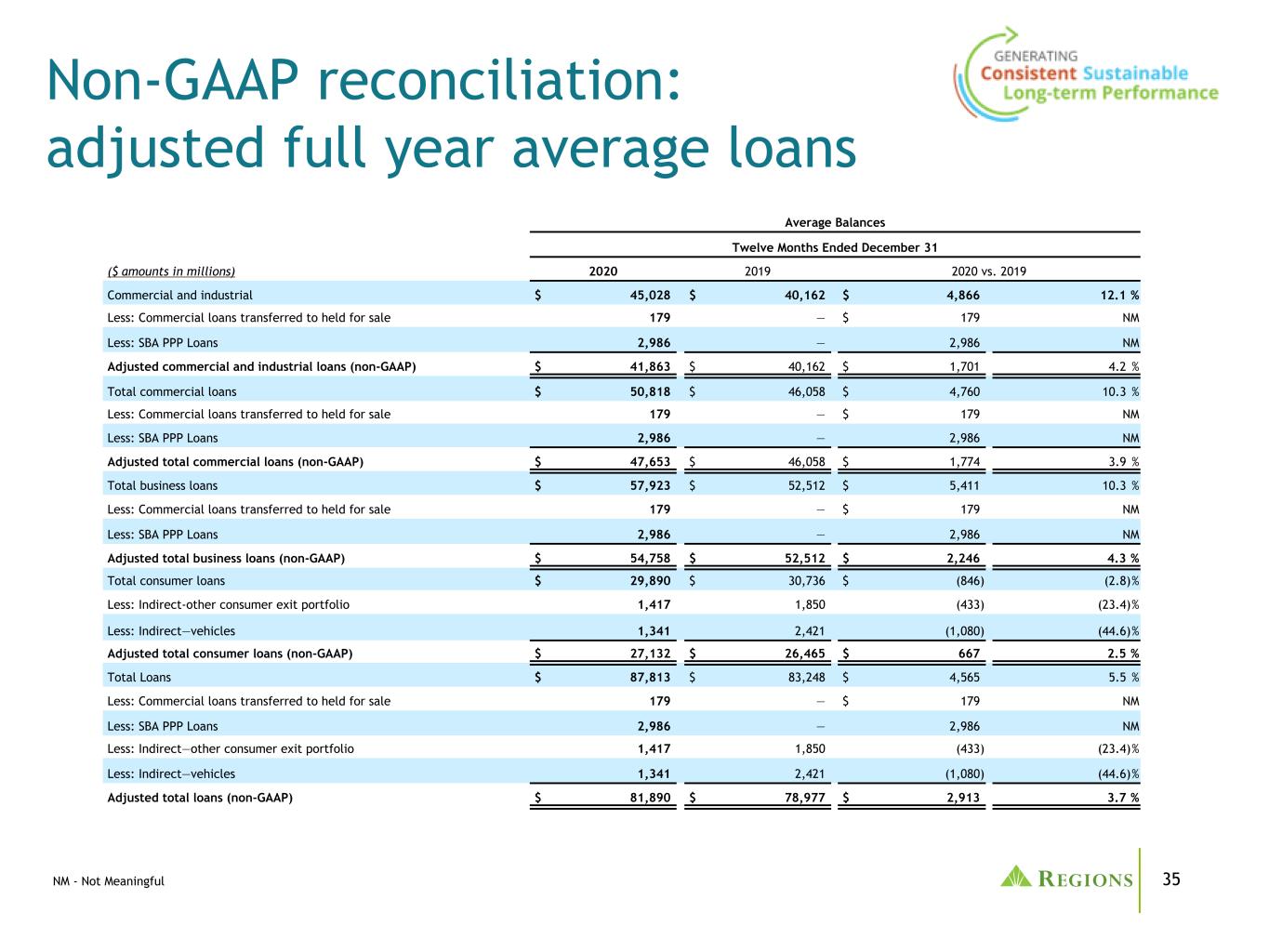
35 Non-GAAP reconciliation: adjusted full year average loans Average Balances Twelve Months Ended December 31 ($ amounts in millions) 2020 2019 2020 vs. 2019 Commercial and industrial $ 45,028 $ 40,162 $ 4,866 12.1 % Less: Commercial loans transferred to held for sale 179 — $ 179 NM Less: SBA PPP Loans 2,986 — 2,986 NM Adjusted commercial and industrial loans (non-GAAP) $ 41,863 $ 40,162 $ 1,701 4.2 % Total commercial loans $ 50,818 $ 46,058 $ 4,760 10.3 % Less: Commercial loans transferred to held for sale 179 — $ 179 NM Less: SBA PPP Loans 2,986 — 2,986 NM Adjusted total commercial loans (non-GAAP) $ 47,653 $ 46,058 $ 1,774 3.9 % Total business loans $ 57,923 $ 52,512 $ 5,411 10.3 % Less: Commercial loans transferred to held for sale 179 — $ 179 NM Less: SBA PPP Loans 2,986 — 2,986 NM Adjusted total business loans (non-GAAP) $ 54,758 $ 52,512 $ 2,246 4.3 % Total consumer loans $ 29,890 $ 30,736 $ (846) (2.8) % Less: Indirect-other consumer exit portfolio 1,417 1,850 (433) (23.4) % Less: Indirect—vehicles 1,341 2,421 (1,080) (44.6) % Adjusted total consumer loans (non-GAAP) $ 27,132 $ 26,465 $ 667 2.5 % Total Loans $ 87,813 $ 83,248 $ 4,565 5.5 % Less: Commercial loans transferred to held for sale 179 — $ 179 NM Less: SBA PPP Loans 2,986 — 2,986 NM Less: Indirect—other consumer exit portfolio 1,417 1,850 (433) (23.4) % Less: Indirect—vehicles 1,341 2,421 (1,080) (44.6) % Adjusted total loans (non-GAAP) $ 81,890 $ 78,977 $ 2,913 3.7 % NM - Not Meaningful
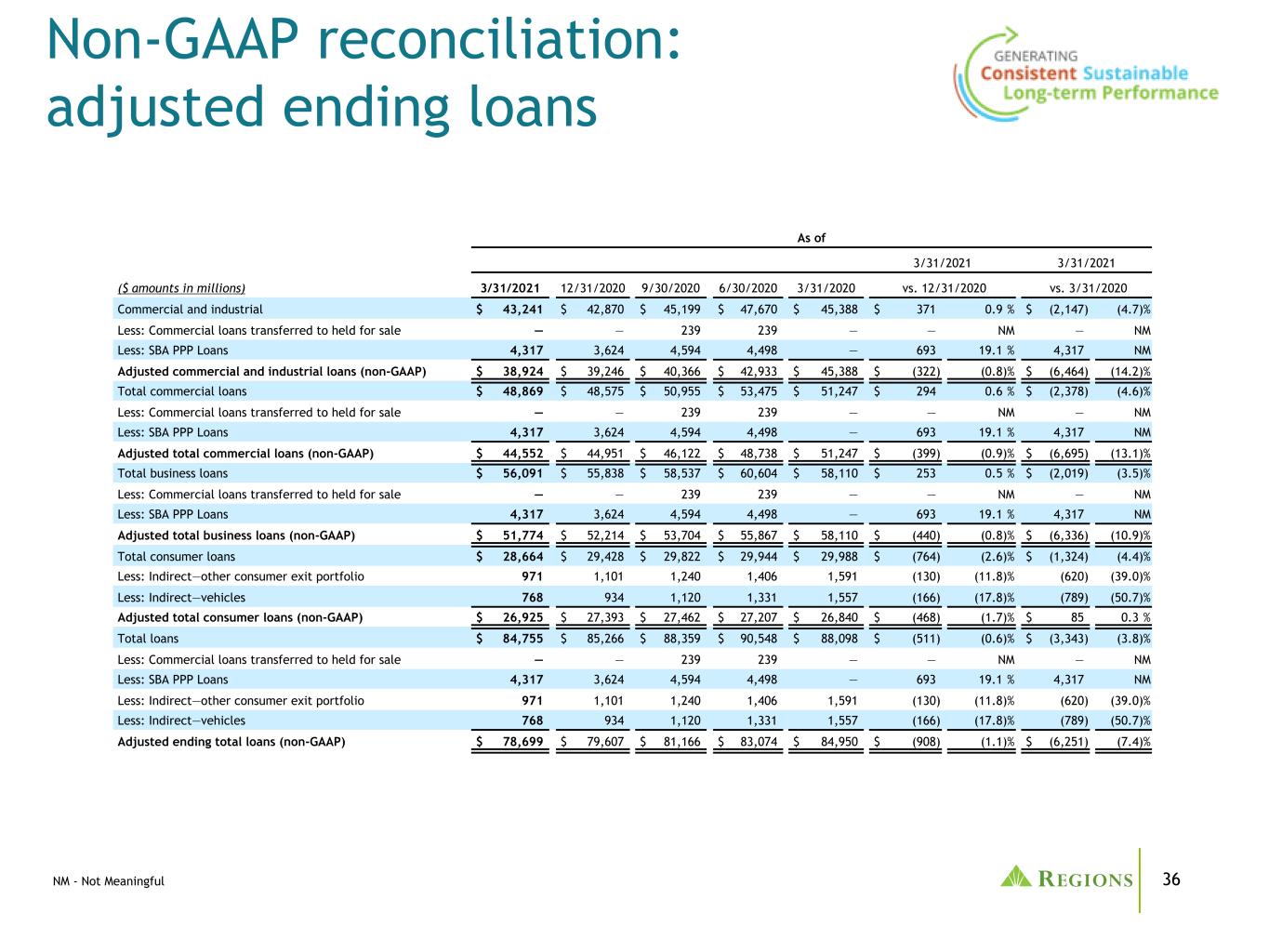
36 Non-GAAP reconciliation: adjusted ending loans As of 3/31/2021 3/31/2021 ($ amounts in millions) 3/31/2021 12/31/2020 9/30/2020 6/30/2020 3/31/2020 vs. 12/31/2020 vs. 3/31/2020 Commercial and industrial $ 43,241 $ 42,870 $ 45,199 $ 47,670 $ 45,388 $ 371 0.9 % $ (2,147) (4.7) % Less: Commercial loans transferred to held for sale — — 239 239 — — NM — NM Less: SBA PPP Loans 4,317 3,624 4,594 4,498 — 693 19.1 % 4,317 NM Adjusted commercial and industrial loans (non-GAAP) $ 38,924 $ 39,246 $ 40,366 $ 42,933 $ 45,388 $ (322) (0.8) % $ (6,464) (14.2) % Total commercial loans $ 48,869 $ 48,575 $ 50,955 $ 53,475 $ 51,247 $ 294 0.6 % $ (2,378) (4.6) % Less: Commercial loans transferred to held for sale — — 239 239 — — NM — NM Less: SBA PPP Loans 4,317 3,624 4,594 4,498 — 693 19.1 % 4,317 NM Adjusted total commercial loans (non-GAAP) $ 44,552 $ 44,951 $ 46,122 $ 48,738 $ 51,247 $ (399) (0.9) % $ (6,695) (13.1) % Total business loans $ 56,091 $ 55,838 $ 58,537 $ 60,604 $ 58,110 $ 253 0.5 % $ (2,019) (3.5) % Less: Commercial loans transferred to held for sale — — 239 239 — — NM — NM Less: SBA PPP Loans 4,317 3,624 4,594 4,498 — 693 19.1 % 4,317 NM Adjusted total business loans (non-GAAP) $ 51,774 $ 52,214 $ 53,704 $ 55,867 $ 58,110 $ (440) (0.8) % $ (6,336) (10.9) % Total consumer loans $ 28,664 $ 29,428 $ 29,822 $ 29,944 $ 29,988 $ (764) (2.6) % $ (1,324) (4.4) % Less: Indirect—other consumer exit portfolio 971 1,101 1,240 1,406 1,591 (130) (11.8) % (620) (39.0) % Less: Indirect—vehicles 768 934 1,120 1,331 1,557 (166) (17.8) % (789) (50.7) % Adjusted total consumer loans (non-GAAP) $ 26,925 $ 27,393 $ 27,462 $ 27,207 $ 26,840 $ (468) (1.7) % $ 85 0.3 % Total loans $ 84,755 $ 85,266 $ 88,359 $ 90,548 $ 88,098 $ (511) (0.6) % $ (3,343) (3.8) % Less: Commercial loans transferred to held for sale — — 239 239 — — NM — NM Less: SBA PPP Loans 4,317 3,624 4,594 4,498 — 693 19.1 % 4,317 NM Less: Indirect—other consumer exit portfolio 971 1,101 1,240 1,406 1,591 (130) (11.8) % (620) (39.0) % Less: Indirect—vehicles 768 934 1,120 1,331 1,557 (166) (17.8) % (789) (50.7) % Adjusted ending total loans (non-GAAP) $ 78,699 $ 79,607 $ 81,166 $ 83,074 $ 84,950 $ (908) (1.1) % $ (6,251) (7.4) % NM - Not Meaningful
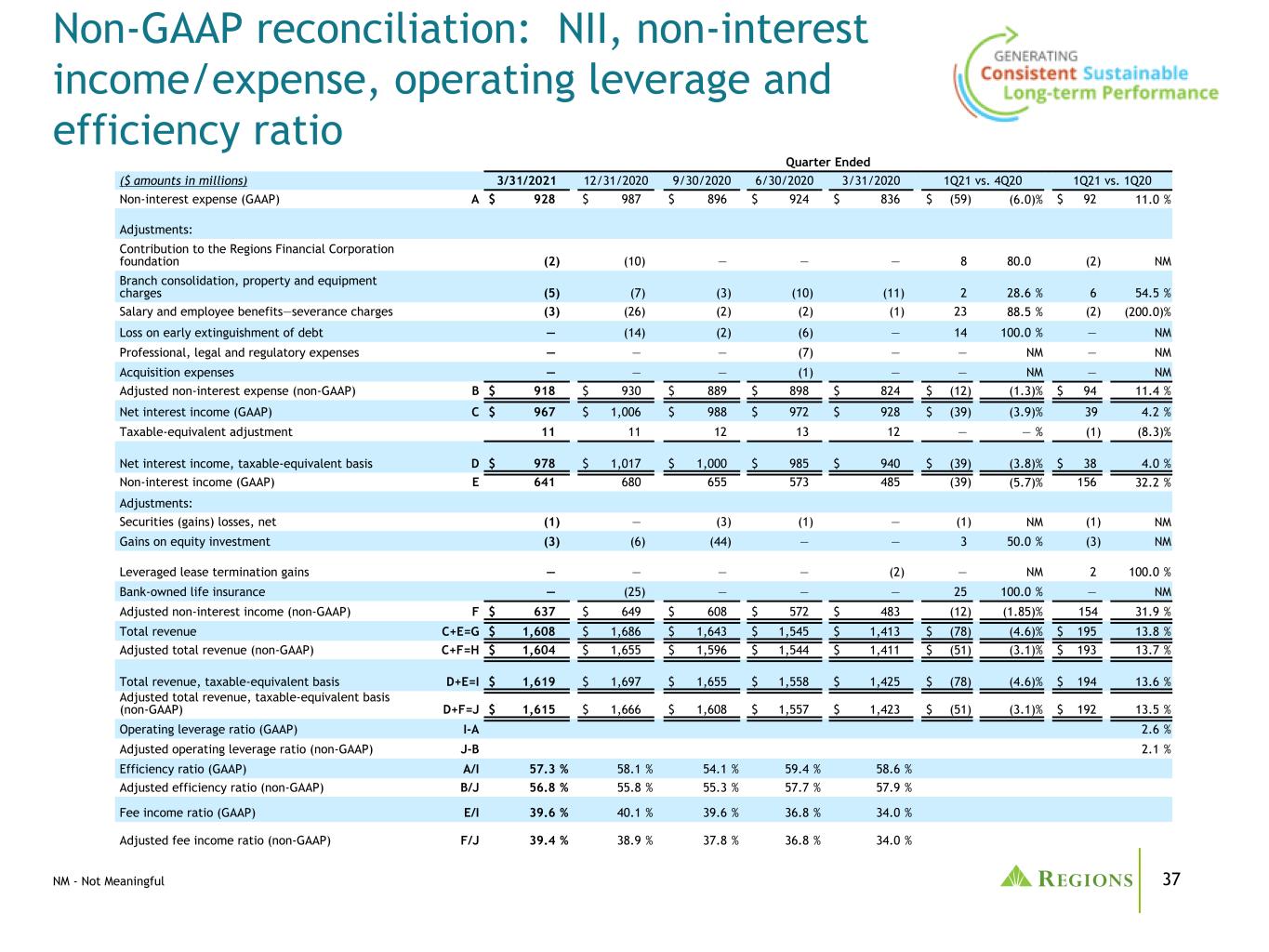
37 Non-GAAP reconciliation: NII, non-interest income/expense, operating leverage and efficiency ratio NM - Not Meaningful Quarter Ended ($ amounts in millions) 3/31/2021 12/31/2020 9/30/2020 6/30/2020 3/31/2020 1Q21 vs. 4Q20 1Q21 vs. 1Q20 Non-interest expense (GAAP) A $ 928 $ 987 $ 896 $ 924 $ 836 $ (59) (6.0) % $ 92 11.0 % Adjustments: Contribution to the Regions Financial Corporation foundation (2) (10) — — — 8 80.0 (2) NM Branch consolidation, property and equipment charges (5) (7) (3) (10) (11) 2 28.6 % 6 54.5 % Salary and employee benefits—severance charges (3) (26) (2) (2) (1) 23 88.5 % (2) (200.0) % Loss on early extinguishment of debt — (14) (2) (6) — 14 100.0 % — NM Professional, legal and regulatory expenses — — — (7) — — NM — NM Acquisition expenses — — — (1) — — NM — NM Adjusted non-interest expense (non-GAAP) B $ 918 $ 930 $ 889 $ 898 $ 824 $ (12) (1.3) % $ 94 11.4 % Net interest income (GAAP) C $ 967 $ 1,006 $ 988 $ 972 $ 928 $ (39) (3.9) % 39 4.2 % Taxable-equivalent adjustment 11 11 12 13 12 — — % (1) (8.3) % Net interest income, taxable-equivalent basis D $ 978 $ 1,017 $ 1,000 $ 985 $ 940 $ (39) (3.8) % $ 38 4.0 % Non-interest income (GAAP) E 641 680 655 573 485 (39) (5.7) % 156 32.2 % Adjustments: Securities (gains) losses, net (1) — (3) (1) — (1) NM (1) NM Gains on equity investment (3) (6) (44) — — 3 50.0 % (3) NM Leveraged lease termination gains — — — — (2) — NM 2 100.0 % Bank-owned life insurance — (25) — — — 25 100.0 % — NM Adjusted non-interest income (non-GAAP) F $ 637 $ 649 $ 608 $ 572 $ 483 (12) (1.85) % 154 31.9 % Total revenue C+E=G $ 1,608 $ 1,686 $ 1,643 $ 1,545 $ 1,413 $ (78) (4.6) % $ 195 13.8 % Adjusted total revenue (non-GAAP) C+F=H $ 1,604 $ 1,655 $ 1,596 $ 1,544 $ 1,411 $ (51) (3.1) % $ 193 13.7 % Total revenue, taxable-equivalent basis D+E=I $ 1,619 $ 1,697 $ 1,655 $ 1,558 $ 1,425 $ (78) (4.6) % $ 194 13.6 % Adjusted total revenue, taxable-equivalent basis (non-GAAP) D+F=J $ 1,615 $ 1,666 $ 1,608 $ 1,557 $ 1,423 $ (51) (3.1) % $ 192 13.5 % Operating leverage ratio (GAAP) I-A 2.6 % Adjusted operating leverage ratio (non-GAAP) J-B 2.1 % Efficiency ratio (GAAP) A/I 57.3 % 58.1 % 54.1 % 59.4 % 58.6 % Adjusted efficiency ratio (non-GAAP) B/J 56.8 % 55.8 % 55.3 % 57.7 % 57.9 % Fee income ratio (GAAP) E/I 39.6 % 40.1 % 39.6 % 36.8 % 34.0 % Adjusted fee income ratio (non-GAAP) F/J 39.4 % 38.9 % 37.8 % 36.8 % 34.0 %
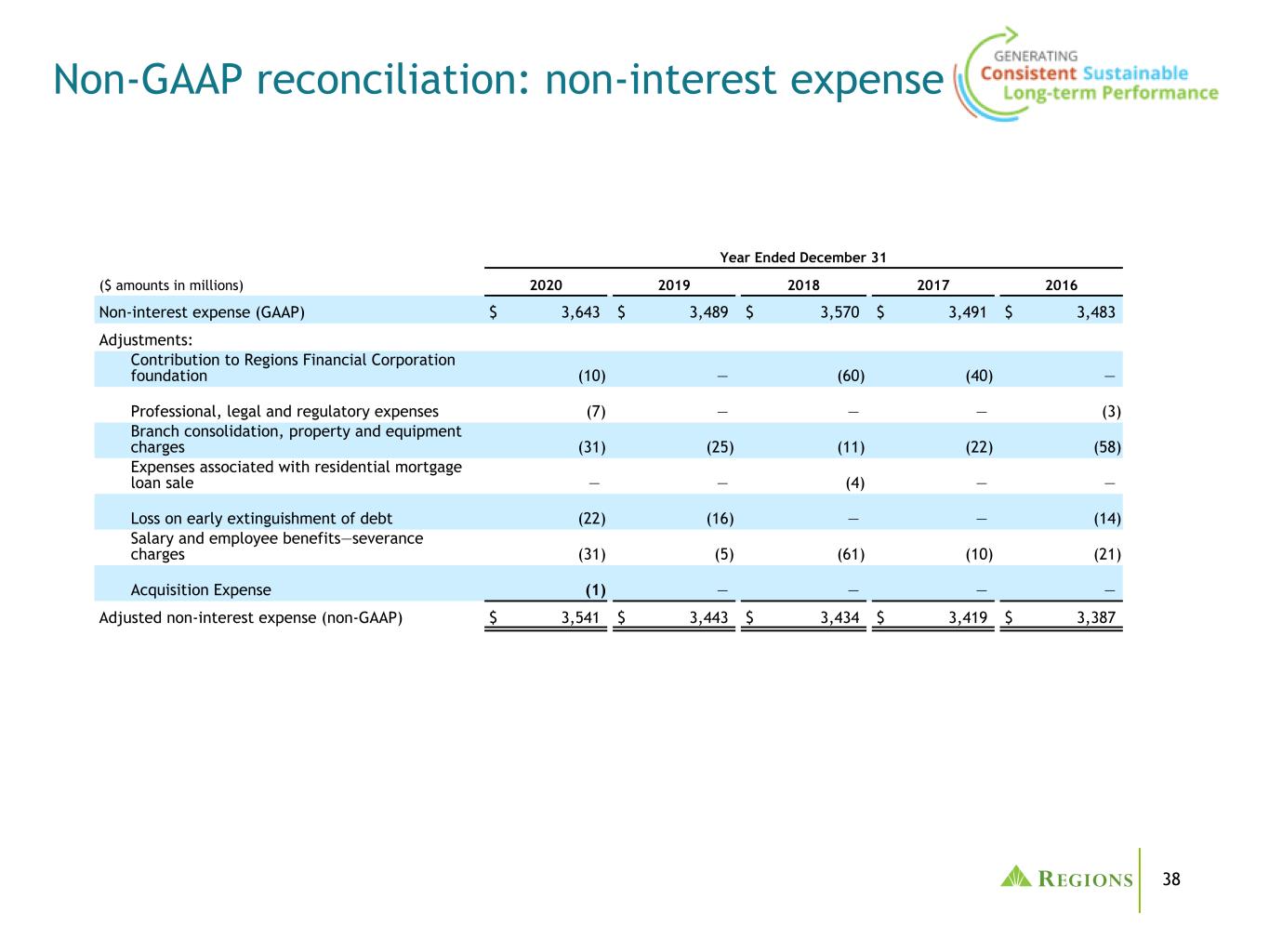
38 Non-GAAP reconciliation: non-interest expense Year Ended December 31 ($ amounts in millions) 2020 2019 2018 2017 2016 Non-interest expense (GAAP) $ 3,643 $ 3,489 $ 3,570 $ 3,491 $ 3,483 Adjustments: Contribution to Regions Financial Corporation foundation (10) — (60) (40) — Professional, legal and regulatory expenses (7) — — — (3) Branch consolidation, property and equipment charges (31) (25) (11) (22) (58) Expenses associated with residential mortgage loan sale — — (4) — — Loss on early extinguishment of debt (22) (16) — — (14) Salary and employee benefits—severance charges (31) (5) (61) (10) (21) Acquisition Expense (1) — — — — Adjusted non-interest expense (non-GAAP) $ 3,541 $ 3,443 $ 3,434 $ 3,419 $ 3,387
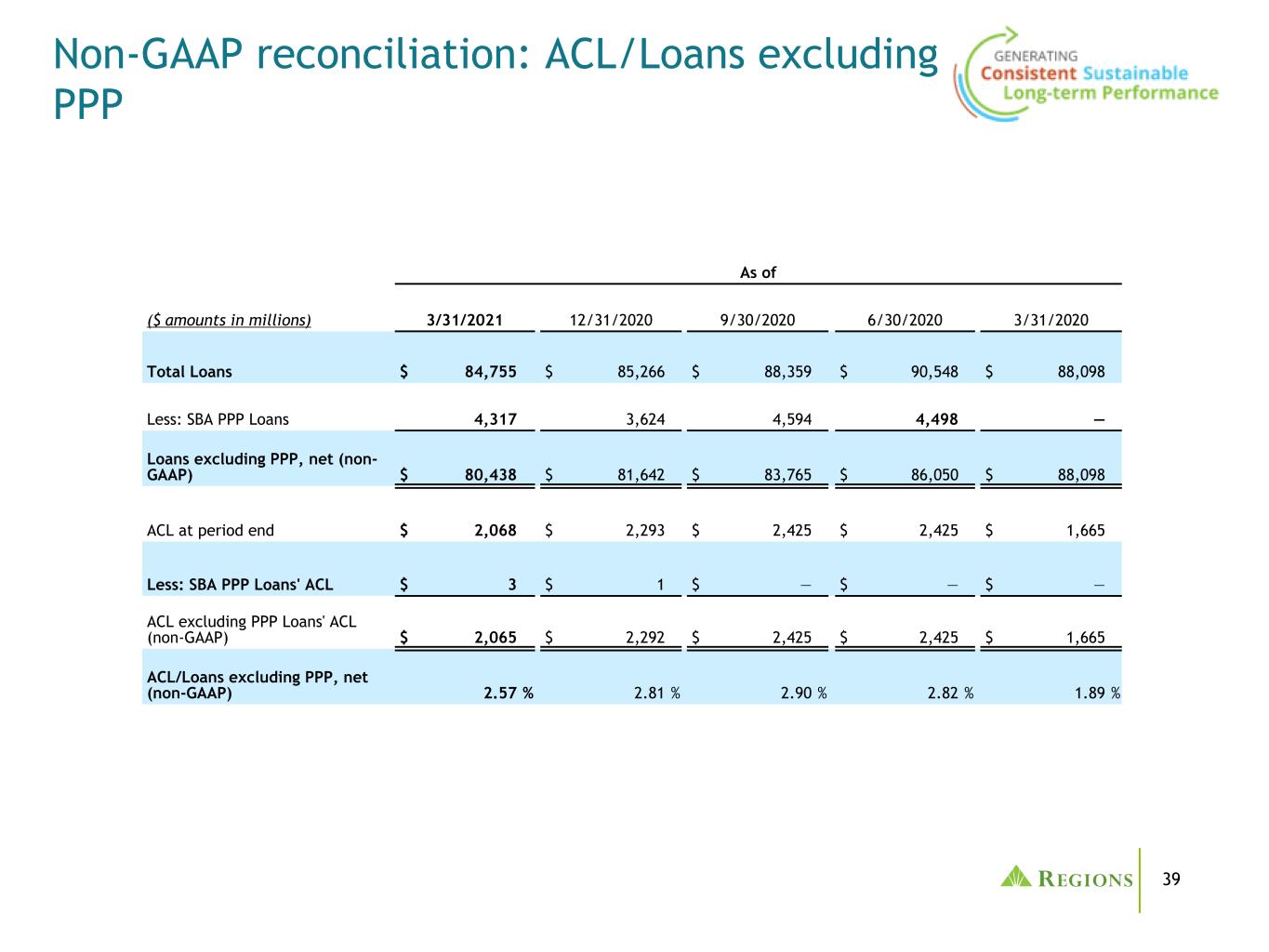
39 Non-GAAP reconciliation: ACL/Loans excluding PPP As of ($ amounts in millions) 3/31/2021 12/31/2020 9/30/2020 6/30/2020 3/31/2020 Total Loans $ 84,755 $ 85,266 $ 88,359 $ 90,548 $ 88,098 Less: SBA PPP Loans 4,317 3,624 4,594 4,498 — Loans excluding PPP, net (non- GAAP) $ 80,438 $ 81,642 $ 83,765 $ 86,050 $ 88,098 ACL at period end $ 2,068 $ 2,293 $ 2,425 $ 2,425 $ 1,665 Less: SBA PPP Loans' ACL $ 3 $ 1 $ — $ — $ — ACL excluding PPP Loans' ACL (non-GAAP) $ 2,065 $ 2,292 $ 2,425 $ 2,425 $ 1,665 ACL/Loans excluding PPP, net (non-GAAP) 2.57 % 2.81 % 2.90 % 2.82 % 1.89 %
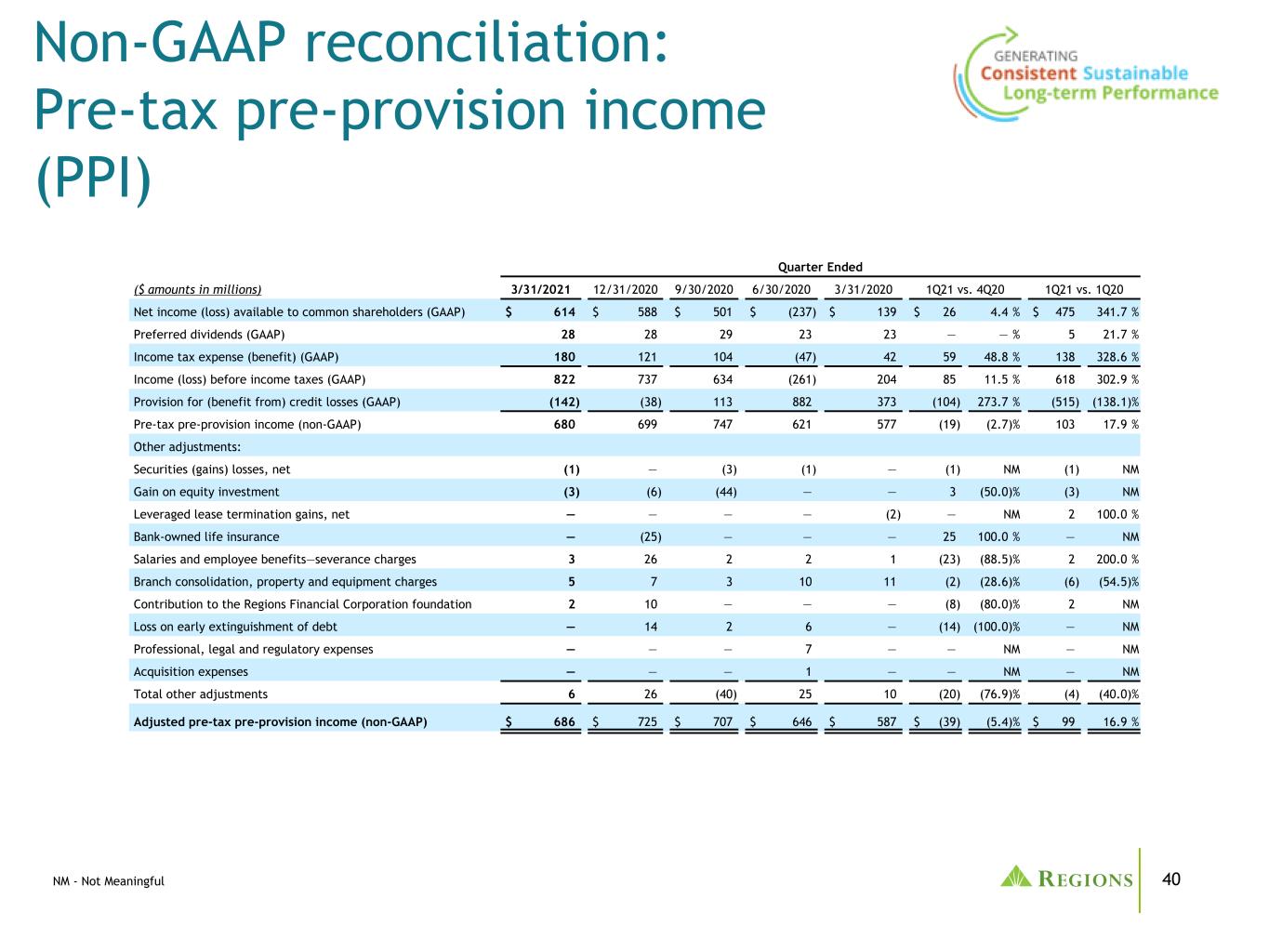
40 Non-GAAP reconciliation: Pre-tax pre-provision income (PPI) Quarter Ended ($ amounts in millions) 3/31/2021 12/31/2020 9/30/2020 6/30/2020 3/31/2020 1Q21 vs. 4Q20 1Q21 vs. 1Q20 Net income (loss) available to common shareholders (GAAP) $ 614 $ 588 $ 501 $ (237) $ 139 $ 26 4.4 % $ 475 341.7 % Preferred dividends (GAAP) 28 28 29 23 23 — — % 5 21.7 % Income tax expense (benefit) (GAAP) 180 121 104 (47) 42 59 48.8 % 138 328.6 % Income (loss) before income taxes (GAAP) 822 737 634 (261) 204 85 11.5 % 618 302.9 % Provision for (benefit from) credit losses (GAAP) (142) (38) 113 882 373 (104) 273.7 % (515) (138.1) % Pre-tax pre-provision income (non-GAAP) 680 699 747 621 577 (19) (2.7) % 103 17.9 % Other adjustments: Securities (gains) losses, net (1) — (3) (1) — (1) NM (1) NM Gain on equity investment (3) (6) (44) — — 3 (50.0) % (3) NM Leveraged lease termination gains, net — — — — (2) — NM 2 100.0 % Bank-owned life insurance — (25) — — — 25 100.0 % — NM Salaries and employee benefits—severance charges 3 26 2 2 1 (23) (88.5) % 2 200.0 % Branch consolidation, property and equipment charges 5 7 3 10 11 (2) (28.6) % (6) (54.5) % Contribution to the Regions Financial Corporation foundation 2 10 — — — (8) (80.0) % 2 NM Loss on early extinguishment of debt — 14 2 6 — (14) (100.0) % — NM Professional, legal and regulatory expenses — — — 7 — — NM — NM Acquisition expenses — — — 1 — — NM — NM Total other adjustments 6 26 (40) 25 10 (20) (76.9) % (4) (40.0) % Adjusted pre-tax pre-provision income (non-GAAP) $ 686 $ 725 $ 707 $ 646 $ 587 $ (39) (5.4) % $ 99 16.9 % NM - Not Meaningful
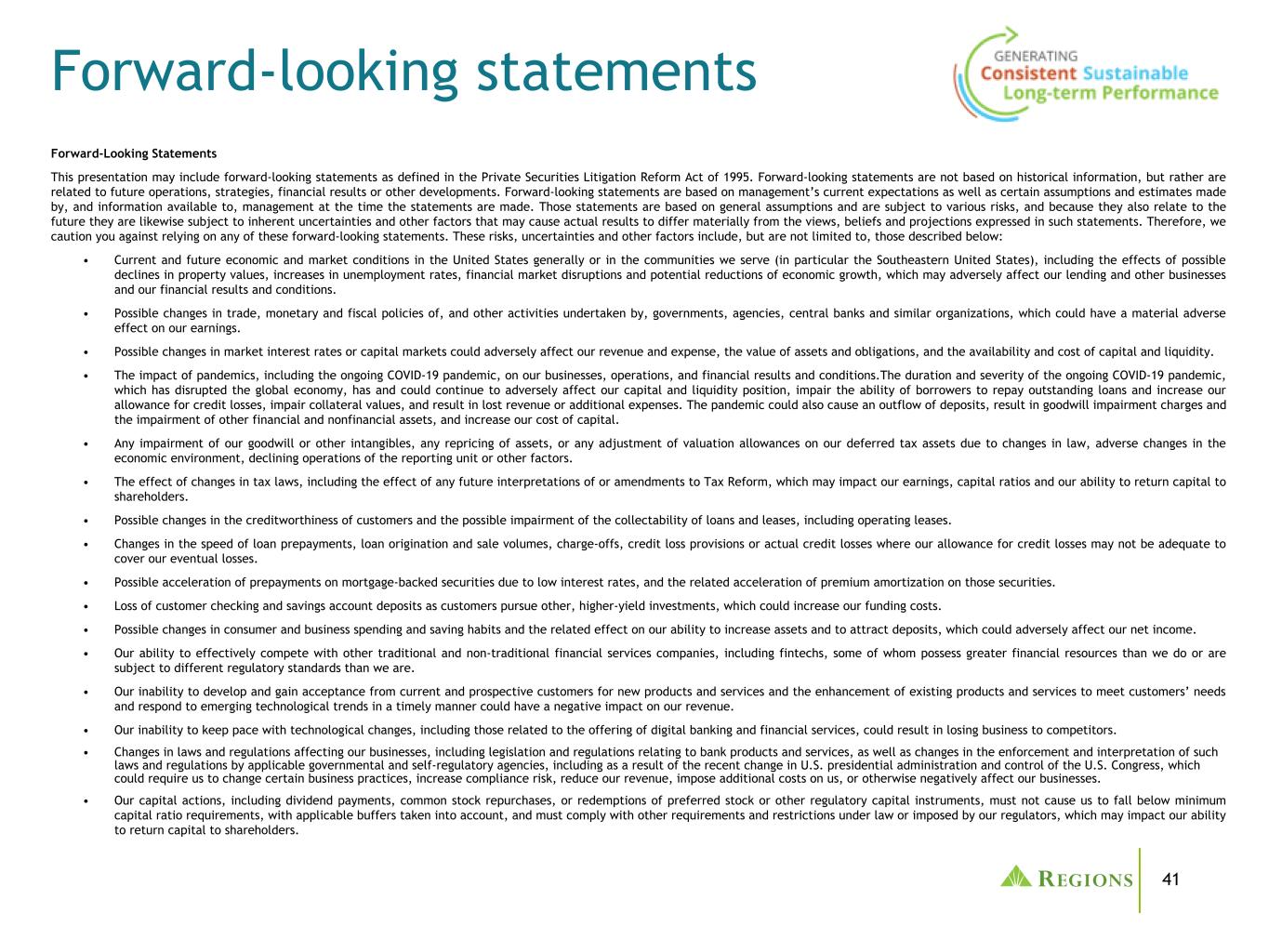
41 Forward-Looking Statements This presentation may include forward-looking statements as defined in the Private Securities Litigation Reform Act of 1995. Forward-looking statements are not based on historical information, but rather are related to future operations, strategies, financial results or other developments. Forward-looking statements are based on management’s current expectations as well as certain assumptions and estimates made by, and information available to, management at the time the statements are made. Those statements are based on general assumptions and are subject to various risks, and because they also relate to the future they are likewise subject to inherent uncertainties and other factors that may cause actual results to differ materially from the views, beliefs and projections expressed in such statements. Therefore, we caution you against relying on any of these forward-looking statements. These risks, uncertainties and other factors include, but are not limited to, those described below: • Current and future economic and market conditions in the United States generally or in the communities we serve (in particular the Southeastern United States), including the effects of possible declines in property values, increases in unemployment rates, financial market disruptions and potential reductions of economic growth, which may adversely affect our lending and other businesses and our financial results and conditions. • Possible changes in trade, monetary and fiscal policies of, and other activities undertaken by, governments, agencies, central banks and similar organizations, which could have a material adverse effect on our earnings. • Possible changes in market interest rates or capital markets could adversely affect our revenue and expense, the value of assets and obligations, and the availability and cost of capital and liquidity. • The impact of pandemics, including the ongoing COVID-19 pandemic, on our businesses, operations, and financial results and conditions.The duration and severity of the ongoing COVID-19 pandemic, which has disrupted the global economy, has and could continue to adversely affect our capital and liquidity position, impair the ability of borrowers to repay outstanding loans and increase our allowance for credit losses, impair collateral values, and result in lost revenue or additional expenses. The pandemic could also cause an outflow of deposits, result in goodwill impairment charges and the impairment of other financial and nonfinancial assets, and increase our cost of capital. • Any impairment of our goodwill or other intangibles, any repricing of assets, or any adjustment of valuation allowances on our deferred tax assets due to changes in law, adverse changes in the economic environment, declining operations of the reporting unit or other factors. • The effect of changes in tax laws, including the effect of any future interpretations of or amendments to Tax Reform, which may impact our earnings, capital ratios and our ability to return capital to shareholders. • Possible changes in the creditworthiness of customers and the possible impairment of the collectability of loans and leases, including operating leases. • Changes in the speed of loan prepayments, loan origination and sale volumes, charge-offs, credit loss provisions or actual credit losses where our allowance for credit losses may not be adequate to cover our eventual losses. • Possible acceleration of prepayments on mortgage-backed securities due to low interest rates, and the related acceleration of premium amortization on those securities. • Loss of customer checking and savings account deposits as customers pursue other, higher-yield investments, which could increase our funding costs. • Possible changes in consumer and business spending and saving habits and the related effect on our ability to increase assets and to attract deposits, which could adversely affect our net income. • Our ability to effectively compete with other traditional and non-traditional financial services companies, including fintechs, some of whom possess greater financial resources than we do or are subject to different regulatory standards than we are. • Our inability to develop and gain acceptance from current and prospective customers for new products and services and the enhancement of existing products and services to meet customers’ needs and respond to emerging technological trends in a timely manner could have a negative impact on our revenue. • Our inability to keep pace with technological changes, including those related to the offering of digital banking and financial services, could result in losing business to competitors. • Changes in laws and regulations affecting our businesses, including legislation and regulations relating to bank products and services, as well as changes in the enforcement and interpretation of such laws and regulations by applicable governmental and self-regulatory agencies, including as a result of the recent change in U.S. presidential administration and control of the U.S. Congress, which could require us to change certain business practices, increase compliance risk, reduce our revenue, impose additional costs on us, or otherwise negatively affect our businesses. • Our capital actions, including dividend payments, common stock repurchases, or redemptions of preferred stock or other regulatory capital instruments, must not cause us to fall below minimum capital ratio requirements, with applicable buffers taken into account, and must comply with other requirements and restrictions under law or imposed by our regulators, which may impact our ability to return capital to shareholders. Forward-looking statements
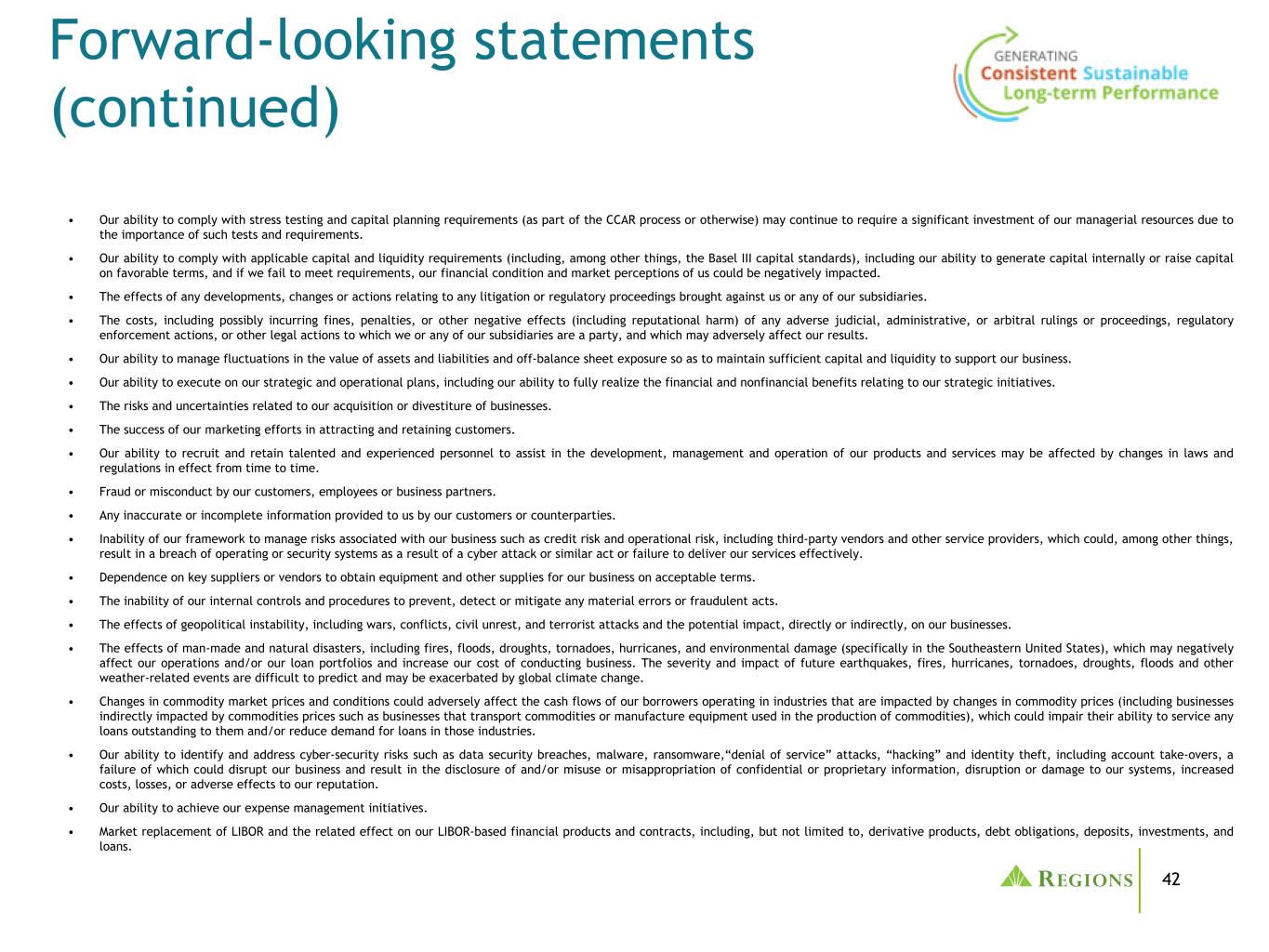
42 • Our ability to comply with stress testing and capital planning requirements (as part of the CCAR process or otherwise) may continue to require a significant investment of our managerial resources due to the importance of such tests and requirements. • Our ability to comply with applicable capital and liquidity requirements (including, among other things, the Basel III capital standards), including our ability to generate capital internally or raise capital on favorable terms, and if we fail to meet requirements, our financial condition and market perceptions of us could be negatively impacted. • The effects of any developments, changes or actions relating to any litigation or regulatory proceedings brought against us or any of our subsidiaries. • The costs, including possibly incurring fines, penalties, or other negative effects (including reputational harm) of any adverse judicial, administrative, or arbitral rulings or proceedings, regulatory enforcement actions, or other legal actions to which we or any of our subsidiaries are a party, and which may adversely affect our results. • Our ability to manage fluctuations in the value of assets and liabilities and off-balance sheet exposure so as to maintain sufficient capital and liquidity to support our business. • Our ability to execute on our strategic and operational plans, including our ability to fully realize the financial and nonfinancial benefits relating to our strategic initiatives. • The risks and uncertainties related to our acquisition or divestiture of businesses. • The success of our marketing efforts in attracting and retaining customers. • Our ability to recruit and retain talented and experienced personnel to assist in the development, management and operation of our products and services may be affected by changes in laws and regulations in effect from time to time. • Fraud or misconduct by our customers, employees or business partners. • Any inaccurate or incomplete information provided to us by our customers or counterparties. • Inability of our framework to manage risks associated with our business such as credit risk and operational risk, including third-party vendors and other service providers, which could, among other things, result in a breach of operating or security systems as a result of a cyber attack or similar act or failure to deliver our services effectively. • Dependence on key suppliers or vendors to obtain equipment and other supplies for our business on acceptable terms. • The inability of our internal controls and procedures to prevent, detect or mitigate any material errors or fraudulent acts. • The effects of geopolitical instability, including wars, conflicts, civil unrest, and terrorist attacks and the potential impact, directly or indirectly, on our businesses. • The effects of man-made and natural disasters, including fires, floods, droughts, tornadoes, hurricanes, and environmental damage (specifically in the Southeastern United States), which may negatively affect our operations and/or our loan portfolios and increase our cost of conducting business. The severity and impact of future earthquakes, fires, hurricanes, tornadoes, droughts, floods and other weather-related events are difficult to predict and may be exacerbated by global climate change. • Changes in commodity market prices and conditions could adversely affect the cash flows of our borrowers operating in industries that are impacted by changes in commodity prices (including businesses indirectly impacted by commodities prices such as businesses that transport commodities or manufacture equipment used in the production of commodities), which could impair their ability to service any loans outstanding to them and/or reduce demand for loans in those industries. • Our ability to identify and address cyber-security risks such as data security breaches, malware, ransomware,“denial of service” attacks, “hacking” and identity theft, including account take-overs, a failure of which could disrupt our business and result in the disclosure of and/or misuse or misappropriation of confidential or proprietary information, disruption or damage to our systems, increased costs, losses, or adverse effects to our reputation. • Our ability to achieve our expense management initiatives. • Market replacement of LIBOR and the related effect on our LIBOR-based financial products and contracts, including, but not limited to, derivative products, debt obligations, deposits, investments, and loans. Forward-looking statements (continued)
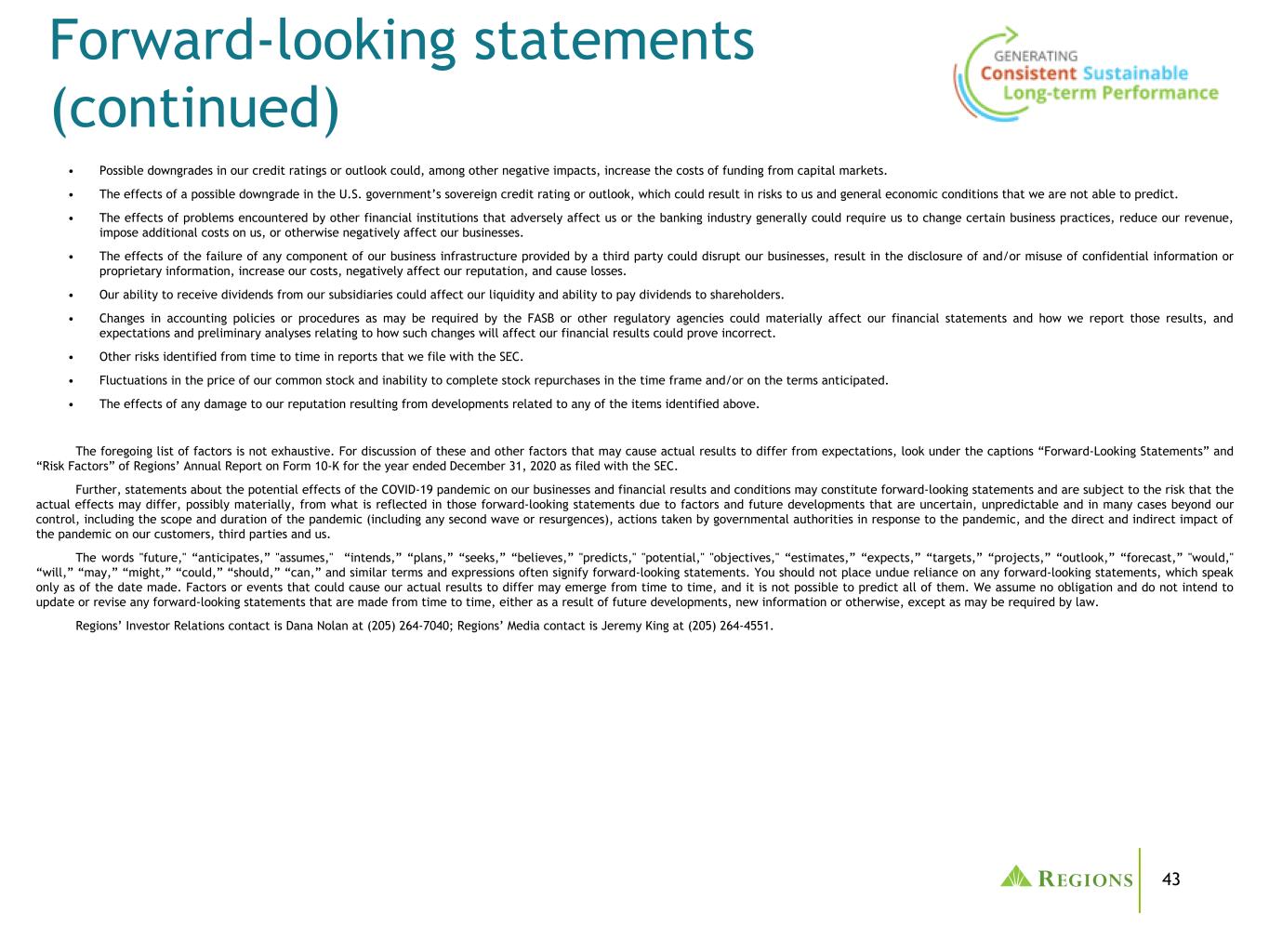
43 • Possible downgrades in our credit ratings or outlook could, among other negative impacts, increase the costs of funding from capital markets. • The effects of a possible downgrade in the U.S. government’s sovereign credit rating or outlook, which could result in risks to us and general economic conditions that we are not able to predict. • The effects of problems encountered by other financial institutions that adversely affect us or the banking industry generally could require us to change certain business practices, reduce our revenue, impose additional costs on us, or otherwise negatively affect our businesses. • The effects of the failure of any component of our business infrastructure provided by a third party could disrupt our businesses, result in the disclosure of and/or misuse of confidential information or proprietary information, increase our costs, negatively affect our reputation, and cause losses. • Our ability to receive dividends from our subsidiaries could affect our liquidity and ability to pay dividends to shareholders. • Changes in accounting policies or procedures as may be required by the FASB or other regulatory agencies could materially affect our financial statements and how we report those results, and expectations and preliminary analyses relating to how such changes will affect our financial results could prove incorrect. • Other risks identified from time to time in reports that we file with the SEC. • Fluctuations in the price of our common stock and inability to complete stock repurchases in the time frame and/or on the terms anticipated. • The effects of any damage to our reputation resulting from developments related to any of the items identified above. The foregoing list of factors is not exhaustive. For discussion of these and other factors that may cause actual results to differ from expectations, look under the captions “Forward-Looking Statements” and “Risk Factors” of Regions’ Annual Report on Form 10-K for the year ended December 31, 2020 as filed with the SEC. Further, statements about the potential effects of the COVID-19 pandemic on our businesses and financial results and conditions may constitute forward-looking statements and are subject to the risk that the actual effects may differ, possibly materially, from what is reflected in those forward-looking statements due to factors and future developments that are uncertain, unpredictable and in many cases beyond our control, including the scope and duration of the pandemic (including any second wave or resurgences), actions taken by governmental authorities in response to the pandemic, and the direct and indirect impact of the pandemic on our customers, third parties and us. The words "future," “anticipates,” "assumes," “intends,” “plans,” “seeks,” “believes,” "predicts," "potential," "objectives," “estimates,” “expects,” “targets,” “projects,” “outlook,” “forecast,” "would," “will,” “may,” “might,” “could,” “should,” “can,” and similar terms and expressions often signify forward-looking statements. You should not place undue reliance on any forward-looking statements, which speak only as of the date made. Factors or events that could cause our actual results to differ may emerge from time to time, and it is not possible to predict all of them. We assume no obligation and do not intend to update or revise any forward-looking statements that are made from time to time, either as a result of future developments, new information or otherwise, except as may be required by law. Regions’ Investor Relations contact is Dana Nolan at (205) 264-7040; Regions’ Media contact is Jeremy King at (205) 264-4551. Forward-looking statements (continued)
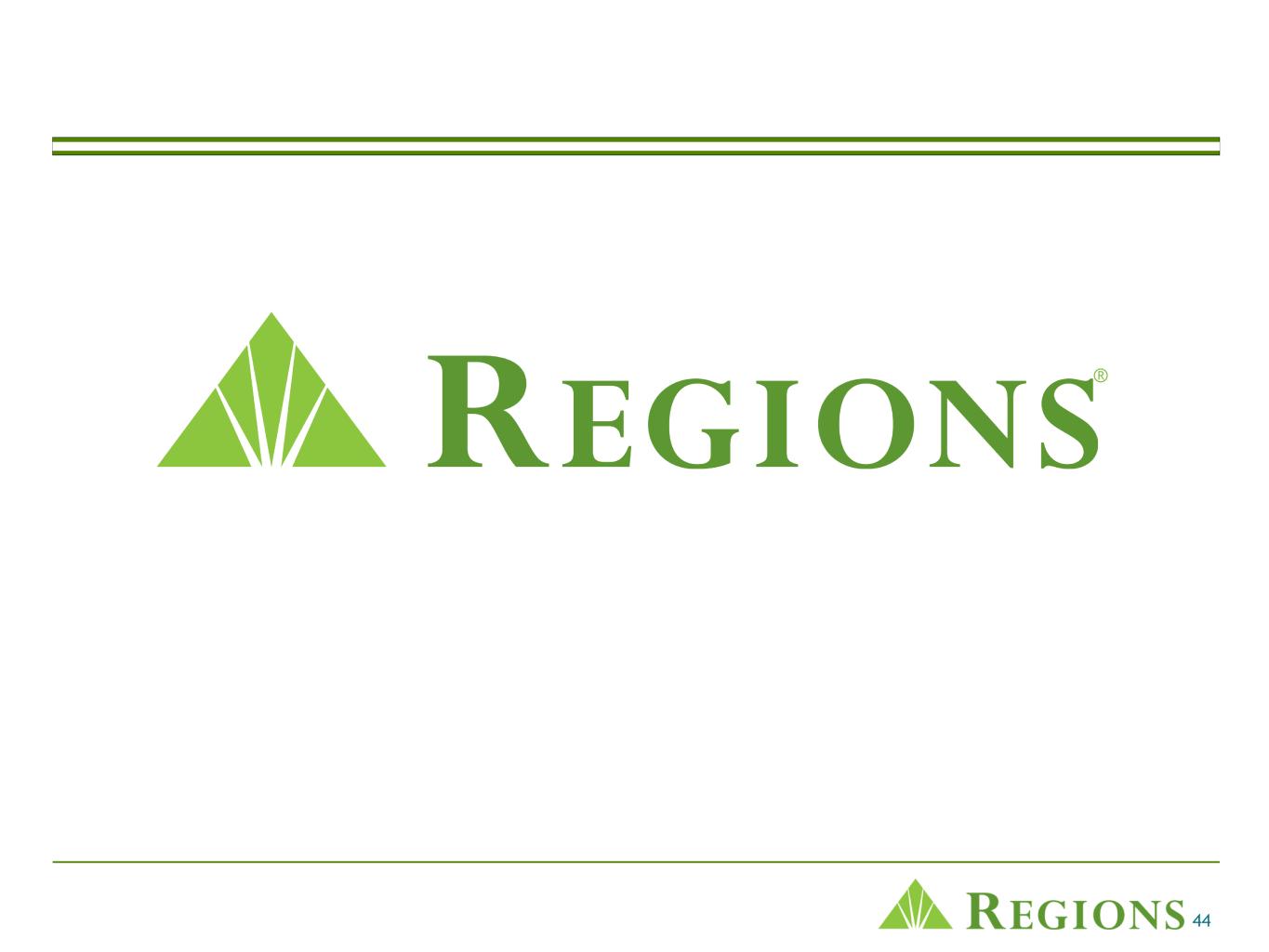
44 ®











































